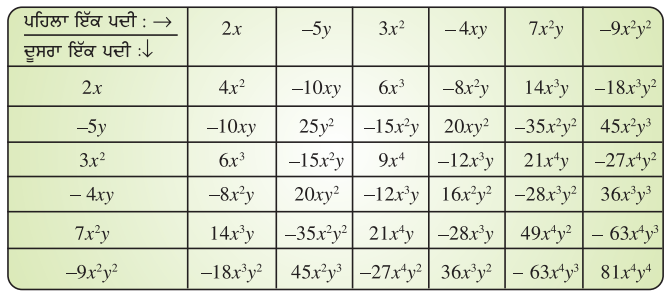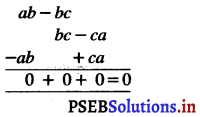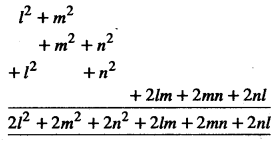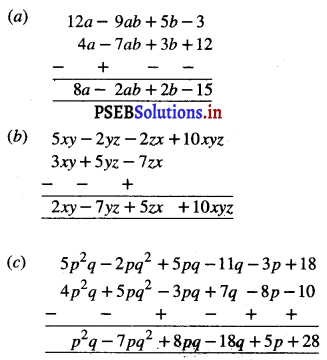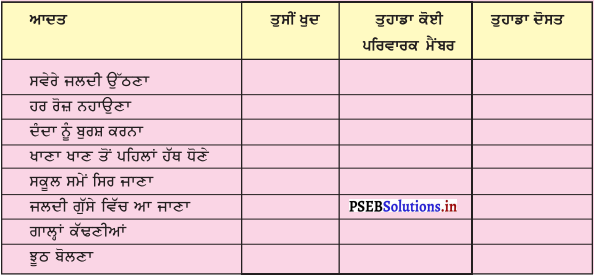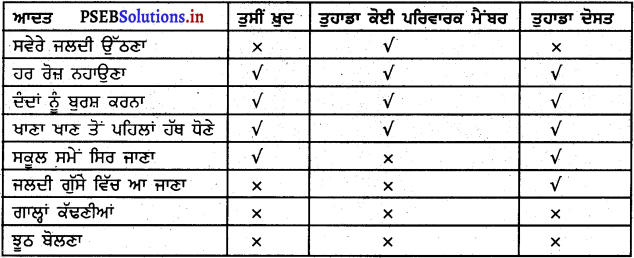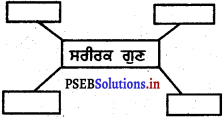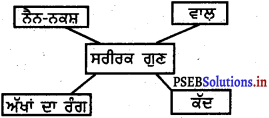Punjab State Board PSEB 6th Class Punjabi Book Solutions Punjabi Rachana Chithi Patar ਰਚਨਾ ਚਿੱਠੀ-ਪੱਤਰ Exercise Questions and Answers.
PSEB 6th Class Hindi Punjabi Rachana ਚਿੱਠੀ-ਪੱਤਰ (1st Language)
ਪ੍ਰਸ਼ਨ 1.
ਆਪਣੇ ਪਿਤਾ ਜੀ ਨੂੰ ਆਪਣੇ ਸਾਲਾਨਾ ਇਮਤਿਹਾਨ ਵਿਚ ਪਾਸ ਹੋਣ ਦੀ ਖ਼ਬਰ ਦੇਣ ਲਈ ਇਕ ਚਿੱਠੀ ਲਿਖੋ।
ਜਾਂ
ਆਪਣੇ ਪਿਤਾ ਜੀ ਤੋਂ ਕਿਤਾਬਾਂ ਅਤੇ ਕਾਪੀਆਂ ਖ਼ਰੀਦਣ ਲਈ ਪੈਸੇ ਮੰਗਵਾਉਣ ਲਈ ਚਿੱਠੀ। ਲਿਖੋ।
ਉੱਤਰ :
ਪ੍ਰੀਖਿਆ ਭਵਨ,
……… ਸਕੂਲ,
………. ਸ਼ਹਿਰ।
5 ਅਪਰੈਲ, 20…..
ਸਤਿਕਾਰਯੋਗ ਪਿਤਾ ਜੀ,
ਸਤਿ ਸ੍ਰੀ ਅਕਾਲ।
ਆਪ ਜੀ ਨੂੰ ਇਹ ਜਾਣ ਕੇ ਬਹੁਤ ਖੁਸ਼ੀ ਹੋਵੇਗੀ ਕਿ ਮੈਂ ਛੇਵੀਂ ਜਮਾਤ ਦਾ ਇਮਤਿਹਾਨ ਪਾਸ ਕਰ ਲਿਆ ਹੈ। ਮੈਂ ਸਾਰੀ ਜਮਾਤ ਵਿਚੋਂ ਪਹਿਲੇ ਨੰਬਰ ‘ਤੇ ਰਿਹਾ ਹਾਂ। ਮੈਂ ਹੁਣ ਸੱਤਵੀਂ ਜਮਾਤ ਵਿਚ ਦਾਖ਼ਲ ਹੋਣਾ ਹੈ ਤੇ ਨਵੀਆਂ ਕਿਤਾਬਾਂ ਤੇ ਕਾਪੀਆਂ ਖ਼ਰੀਦਣੀਆਂ ਹਨ ਆਪ ਜਲਦੀ ਤੋਂ ਜਲਦੀ ਮੈਨੂੰ 1500 ਰੁਪਏ ਭੇਜ ਦੇਵੋ। 15 ਤਰੀਕ ਤੋਂ ਸਾਡੀ ਸੱਤਵੀਂ ਜਮਾਤ ਦੀ ਪੜ੍ਹਾਈ ਸ਼ੁਰੂ ਹੋ ਰਹੀ ਹੈ। ਮਾਤਾ ਜੀ, ਸੰਦੀਪ ਅਤੇ ਨਵਨੀਤ ਵਲੋਂ ਆਪ ਜੀ ਨੂੰ ਸਤਿ ਸ੍ਰੀ ਅਕਾਲ।
ਆਪ ਦਾ ਸਪੁੱਤਰ,
ਅਰਸ਼ਦੀਪ
ਟਿਕਟ ਸ: ਹਰਨੇਕ ਸਿੰਘ, 2815, ਸੈਂਟਰਲ ਟਾਊਨ, ਜਲੰਧਰ !

ਪ੍ਰਸ਼ਨ 2.
ਤੁਹਾਡੇ ਮਾਮਾ (ਚਾਚਾ) ਜੀ ਨੇ ਤੁਹਾਡੇ ਜਨਮ – ਦਿਨ ‘ਤੇ ਤੁਹਾਨੂੰ ਇਕ ਗੁੱਟ – ਘੜੀ ਭੇਜੀ ਹੈ। ਇਕ ਚਿੱਠੀ ਰਾਹੀਂ ਉਨ੍ਹਾਂ ਦਾ ਧੰਨਵਾਦ ਕਰੋ !
ਉੱਤਰ :
ਪ੍ਰੀਖਿਆ ਭਵਨ,
………. ਸਕੂਲ,
……… ਸ਼ਹਿਰ।
16 ਜਨਵਰੀ, 20……….
ਸਤਿਕਾਰਯੋਗ ਮਾਮਾ ਜੀ,
ਸਤਿ ਸ੍ਰੀ ਅਕਾਲ
ਮੈਨੂੰ ਕਲ੍ਹ ਆਪਣੇ ਜਨਮ ਦਿਨ ‘ਤੇ ਤੁਹਾਡੀ ਭੇਜੀ ਹੋਈ ਗੁੱਟ – ਘੜੀ ਮਿਲ ਗਈ ਹੈ। ਇਹ ” ਬਹੁਤ ਹੀ ਸੋਹਣੀ ਹੈ। ਮੈਨੂੰ ਇਸ ਦੀ ਬਹੁਤ ਜ਼ਰੂਰਤ ਸੀ। ਮੇਰੇ ਮਿੱਤਰਾਂ ਨੇ ਇਸ ਦੀ ਬਹੁਤ ਪ੍ਰਸੰਸਾ ਕੀਤੀ ਹੈ। ਇਸ ਨਾਲ ਮੇਰਾ ਜੀਵਨ ਨਿਯਮਬੱਧ ਹੋ ਜਾਵੇਗਾ ਤੇ ਮੈਂ ਪੜ੍ਹਾਈ ਵਲ ਵਧੇਰੇ ਧਿਆਨ ਦੇ ਸਕਾਂਗਾ। ਮੈਂ ਆਪ ਵਲੋਂ ਭੇਜੇ ਇਸ ਤੋਹਫ਼ੇ ਲਈ ਆਪ ਦਾ ਬਹੁਤ ਧੰਨਵਾਦ ਕਰਦਾ ਹਾਂ।
ਆਪ ਦਾ ਭਾਣਜਾ,
ਸੁਰਜੀਤ ਸਿੰਘ॥ ਟਿਕਟ
ਟਿਕਟ ਸ: ਮਨਦੀਪ ਸਿੰਘ, 20, ਮਾਡਲ ਟਾਊਨ, ਹੁਸ਼ਿਆਰਪੁਰ
ਪ੍ਰਸ਼ਨ 3.
ਆਪਣੇ ਜਨਮ – ਦਿਨ ਉੱਤੇ ਆਪਣੇ ਚਾਚੇ ਦੇ ਪੁੱਤਰ ਨੂੰ ਸੱਦਾ – ਪੱਤਰ ਭੇਜੋ।
ਉੱਤਰ :
28, ਸੈਂਟਰਲ ਟਾਊਨ,
ਸੋਨੀਪਤ !
8 ਜਨਵਰੀ, 20…..
ਪਿਆਰੇ ਸਤੀਸ਼,
ਤੈਨੂੰ ਇਹ ਜਾਣ ਕੇ ਬੜੀ ਖ਼ੁਸ਼ੀ ਹੋਵੇਗੀ ਕਿ 11 ਜਨਵਰੀ ਨੂੰ ਮੇਰਾ 11ਵਾਂ ਜਨਮਦਿਨ ਹੈ ਅਤੇ ਮੈਂ ਇਸ ਦਿਨ ਉੱਤੇ ਆਪਣੇ ਮਿੱਤਰਾਂ ਤੇ ਭਰਾਵਾਂ ਨੂੰ ਚਾਹ ਦੀ ਪਾਰਟੀ ਦੇ ਰਿਹਾ ਹਾਂ। ਇਸ ਲਈ ਮੈਂ ਤੈਨੂੰ ਇਸ ਦਿਨ ਆਪਣੇ ਜਨਮ – ਦਿਨ ਦੀ ਚਾਹ – ਪਾਰਟੀ ਵਿਚ ਸ਼ਾਮਲ ਹੋਣ ਲਈ ਸੱਦਾ ਦੇ ਰਿਹਾ ਹਾਂ। ਤੂੰ ਆਪਣੇ ਛੋਟੇ ਭਰਾ ਨੂੰ ਨਾਲ ਲੈ ਕੇ 4 ਵਜੇ ਬਾਅਦ ਦੁਪਹਿਰ ਸਾਡੇ ਘਰ ਜ਼ਰੂਰ ਪੁੱਜ ਜਾਵੀਂ। ਆਸ ਹੈ ਕਿ ਤੂੰ ਮੈਨੂੰ ਨਿਰਾਸ਼ ਨਹੀਂ ਕਰੇਂਗਾ।. ਮੇਰੇ ਵਲੋਂ ਚਾਚਾ ਜੀ ਤੇ ਚਾਚੀ ਜੀ ਨੂੰ ਪ੍ਰਣਾਮ ! ਸ਼ੁੱਭ ਇੱਛਾਵਾਂ ਸਹਿਤ।
ਤੇਰਾ ਵੀਰ,
ਅਰੁਣ ਕੁਮਾਰ !
ਟਿਕਟ ਸਤੀਸ਼ ਕੁਮਾਰ, 9208, ਸੈਕਟਰ 26A, ਚੰਡੀਗੜ੍ਹ।

ਪ੍ਰਸ਼ਨ 4.
ਆਪਣੇ ਵੱਡੇ ਭਰਾ ਦੇ ਵਿਆਹ ਉੱਤੇ, ਬਰਾਤ ਵਿਚ ਸ਼ਾਮਲ ਹੋਣ ਲਈ, ਆਪਣੇ ਮਿੱਤਰ ਸਹੇਲੀ ਨੂੰ ਇਕ ਚਿੱਠੀ ਲਿਖੋ।
ਉੱਤਰ :
ਪ੍ਰੀਖਿਆ ਭਵਨ,
……… ਸਕੂਲ,
……… ਸ਼ਹਿਰ !
8 ਦਸੰਬਰ, 20…..
ਪਿਆਰੀ ਅਮਨਦੀਪ,
ਸ਼ੁੱਭ ਇੱਛਾਵਾਂ !
ਤੈਨੂੰ ਪਤਾ ਹੀ ਹੈ ਕਿ ਮੇਰੇ ਵੱਡੇ ਭਰਾ ਦਾ ਵਿਆਹ 18 ਦਸੰਬਰ, 20…. ਦਿਨ ਐਤਵਾਰ ਨੂੰ ਹੋਣਾ ਨਿਸਚਿਤ ਹੋਇਆ ਹੈ। ਇਸ ਦਿਨ ਬਰਾਤ ਸਵੇਰੇ 6 ਵਜੇ ਚੰਡੀਗੜ੍ਹ ਲਈ ਤੁਰੇਗੀ।
ਮੈਂ ਚਾਹੁੰਦੀ ਹਾਂ ਕਿ ਤੂੰ ਬਰਾਤ ਵਿਚ ਸ਼ਾਮਲ ਹੋ ਕੇ ਸਾਡੀਆਂ ਖ਼ੁਸ਼ੀਆਂ ਵਿਚ ਵਾਧਾ ਕਰੇਂ। ਇਸ ਸੰਬੰਧੀ ਮੰਮੀ ਨੇ ਮੈਨੂੰ ਵਿਸ਼ੇਸ਼ ਤੌਰ ਤੇ ਤੈਨੂੰ ਚਿੱਠੀ ਲਿਖਣ ਲਈ ਕਿਹਾ ਹੈ। ਸੋ ਬਰਾਤ ਵਿਚ ਸ਼ਾਮਲ ਹੋਣ ਲਈ ਤੂੰ ਇਕ ਰਾਤ ਪਹਿਲਾਂ ਸਾਡੇ ਕੋਲ ਪੁੱਜ ਜਾਵੇਂ, ਤਾਂ ਵਧੇਰੇ ਠੀਕ ਹੈ। ਅਸੀਂ ਸਾਰੇ ਤੀਬਰਤਾ ਨਾਲ ਤੇਰੀ ਉਡੀਕ ਕਰਾਂਗੇ।
ਤੇਰੀ ਸਹੇਲੀ,
ਮਨਪ੍ਰੀਤ।
ਟਿਕਟ ਅਮਨਦੀਪ ਕੌਰ, 26/ਮਾਡਲ ਟਾਊਨ, ਲੁਧਿਆਣਾ
ਪ੍ਰਸ਼ਨ 5.
ਤੁਹਾਡਾ ਇਕ ਮਿੱਤਰ/ਸਹੇਲੀ ਛੇਵੀਂ ਜਮਾਤ ਵਿਚੋਂ ਫੇਲ੍ਹ ਹੋ ਗਿਆਗਈ ਹੈ ! ਉਸ ਨੂੰ ਇਕ ਚਿੱਠੀ ਰਾਹੀਂ ਹੌਸਲਾ ਦਿਓ।
ਉੱਤਰ :
ਪ੍ਰੀਖਿਆ ਭਵਨ,
………. ਸਕੂਲ,
………. ਸ਼ਹਿਰ।
20 ਅਪ੍ਰੈਲ, 20….
ਪਿਆਰੇ ਬਰਜਿੰਦਰ,
ਮੈਨੂੰ ਇਹ ਜਾਣ ਕੇ ਬਹੁਤ ਦੁੱਖ ਹੋਇਆ ਹੈ ਕਿ ਤੂੰ ਛੇਵੀਂ ਜਮਾਤ ਵਿਚੋਂ ਫੇਲ੍ਹ ਹੋ ਗਿਆ ਹੈਂ। ਮੈਂ ਸਮਝਦਾ ਹਾਂ ਕਿ ਇਸ ਵਿਚ ਤੇਰਾ ਕੋਈ ਕਸੂਰ ਨਹੀਂ। ਤੂੰ ਪਿਛਲੇ ਸਾਲ ਦੋ ਮਹੀਨੇ ਬਿਮਾਰ ਰਿਹਾ ਸੀ ਤੇ ਸਕੂਲ ਨਹੀਂ ਸੀ ਜਾ ਸਕਿਆ। ਇਸ ਕਰਕੇ ਤੇਰੀ ਪੜ੍ਹਾਈ ਬਹੁਤ ਪਛੜ ਗਈ ਸੀ। ਜੇਕਰ ਤੂੰ ਬਿਮਾਰ ਨਾ ਹੁੰਦਾ, ਤਾਂ ਤੂੰ ਕਦੇ ਵੀ ਫੇਲ੍ਹ ਨਾ ਹੁੰਦਾ। ਤੈਨੂੰ ਮੇਰੀ ਇਹੋ ਹੀ ਸਲਾਹ ਹੈ ਕਿ ਤੂੰ ਹੌਸਲਾ ਬਿਲਕੁਲ ਨਾ ਹਾਰ, ਸਗੋਂ ਆਪਣੀ ਸਿਹਤ ਦਾ ਪੂਰਾ – ਪੂਰਾ ਖ਼ਿਆਲ ਰੱਖਦਾ ਹੋਇਆ ਅੱਗੋਂ ਪੜ੍ਹਾਈ ਨੂੰ ਜਾਰੀ ਰੱਖ। ਇਸ ਤਰ੍ਹਾਂ ਆਉਂਦੀ ਪ੍ਰੀਖਿਆ ਵਿਚ ਤੂੰ ਜ਼ਰੂਰ ਹੀ ਪਾਸ ਹੋ ਜਾਵੇਂਗਾ।
ਤੇਰਾ ਮਿੱਤਰ,
ਹਰਜਿੰਦਰ।
ਟਿਕਟ : ਬਰਜਿੰਦਰ ਸਿੰਘ, ਸਪੁੱਤਰ ਸ: ਲਾਲ ਸਿੰਘ, 88, ਫਰੈਂਡਜ਼ ਕਾਲੋਨੀ, ਅੰਮ੍ਰਿਤਸਰ।

ਪ੍ਰਸ਼ਨ 6.
ਤੁਹਾਡਾ ਮਿੱਤਰ/ਸਹੇਲੀ ਛੇਵੀਂ ਜਮਾਤ ਵਿਚੋਂ ਪਾਸ ਹੋ ਗਿਆ/ਗਈ ਹੈ। ਉਸ ਨੂੰ ਇਕ ਵਧਾਈ – ਪੱਤਰ ਲਿਖੋ।
ਉੱਤਰ :
ਪ੍ਰੀਖਿਆ ਭਵਨ,
……….ਸਕੂਲ,
…….. ਸ਼ਹਿਰ !
28 ਅਪਰੈਲ, 20….
ਪਿਆਰੀ ਕੁਲਵਿੰਦਰ,
ਮੈਨੂੰ ਅੱਜ ਹੀ ਮਾਤਾ ਜੀ ਦੀ ਚਿੱਠੀ ਮਿਲੀ। ਉਸ ਵਿਚੋਂ ਇਹ ਪੜ ਕੇ ਬਹੁਤ ਖ਼ੁਸ਼ੀ ਹੋਈ ਹੈ ਕਿ ਤੂੰ ਸਾਰੀ ਜਮਾਤ ਵਿਚੋਂ ਪਹਿਲੇ ਨੰਬਰ ‘ਤੇ ਰਹਿ ਕੇ ਛੇਵੀਂ ਦਾ ਇਮਤਿਹਾਨ ਪਾਸ ਕੀਤਾ ਹੈ। ਮੈਂ ਤੇਰੀ ਸਫਲਤਾ ਉੱਤੇ ਤੈਨੂੰ ਦਿਲੀ ਵਧਾਈ ਭੇਜਦੀ ਹਾਂ। ਆਪ ਦੇ ਮਾਤਾ – ਪਿਤਾ ਨੂੰ ਸਤਿ ਸ੍ਰੀ ਅਕਾਲ।
ਤੇਰੀ ਸਹੇਲੀ,
ਹਰਜੀਤ।
ਟਿਕਟ ਕੁਲਵਿੰਦਰ ਕੌਰ, ਸਪੁੱਤਰੀ ਸ: ਮਹਿੰਦਰ ਸਿੰਘ, 823, ਹਰਨਾਮਦਾਸ ਪੁਰਾ, ਜਲੰਧਰ
ਪ੍ਰਸ਼ਨ 7.
ਤੁਹਾਡਾ ਭਰਾ ਖੇਡਾਂ ਵਿਚ ਬਹੁਤ ਦਿਲਚਸਪੀ ਰੱਖਦਾ ਹੈ, ਪਰ ਪੜ੍ਹਾਈ ਵਿਚ ਨਹੀਂ, ਉਸ ਨੂੰ ਇਕ ਚਿੱਠੀ ਰਾਹੀਂ ਪੜ੍ਹਾਈ ਕਰਨ ਦੀ ਪ੍ਰੇਰਨਾ ਦਿਓ।
ਉੱਤਰ :
ਪ੍ਰੀਖਿਆ ਭਵਨ,
……..ਸਕੂਲ,
ਅੰਮ੍ਰਿਤਸਰ ਤੋਂ
5 ਜਨਵਰੀ, 20….
ਪਿਆਰੇ ਜਸਵਿੰਦਰ,
ਸ਼ੁੱਭ ਇੱਛਾਵਾਂ। ਮੈਨੂੰ ਅੱਜ ਹੀ ਮਾਤਾ ਜੀ ਦੀ ਚਿੱਠੀ ਮਿਲੀ, ਜਿਸ ਵਿਚ ਉਨ੍ਹਾਂ ਮੈਨੂੰ ਲਿਖਿਆ ਹੈ ਕਿ ਤੂੰ ਹਰ ਵੇਲੇ ਖੇਡਾਂ ਵਿਚ ਹੀ ਮਸਤ ਰਹਿੰਦਾ ਹੈਂ ਤੇ ਪੜ੍ਹਾਈ ਵਲ ਬਿਲਕੁਲ ਧਿਆਨ ਨਹੀਂ ਦਿੰਦਾ, ਜਿਸ ਕਰਕੇ ਤੂੰ ਆਪਣੇ ਨੌਮਾਹੀ ਇਮਤਿਹਾਨਾਂ ਵਿਚ ਸਾਰੇ ਮਜ਼ਮੂਨਾਂ ਵਿਚੋਂ ਫੇਲ੍ਹ ਹੋ ਗਿਆ ਹੈਂ। ਮੈਨੂੰ ਤੇਰੀ ਪੜ੍ਹਾਈ ਵਲੋਂ ਇਸ ਲਾਪਰਵਾਹੀ ਨੂੰ ਜਾਣ ਕੇ ਬਹੁਤ ਦੁੱਖ ਹੋਇਆ ਹੈ। ਤੈਨੂੰ ਪਤਾ ਹੈ ਕਿ ਤੇਰਾ ਇਮਤਿਹਾਨ ਤੇਰੇ ਸਿਰ ‘ਤੇ ਆ ਗਿਆ ਹੈ। ਤੈਨੂੰ ਹੁਣ ਖੇਡਾਂ ਵਿਚ ਸਮਾਂ ਖ਼ਰਾਬ ਨਹੀਂ ਕਰਨਾ ਚਾਹੀਦਾ ਮੈਂ ਇਸ ਗੱਲ ਤੋਂ ਇਨਕਾਰ ਨਹੀਂ ਕਰਦਾ ਕਿ ਖੇਡਾਂ ਦੀ ਵਿਦਿਆਰਥੀ ਜੀਵਨ ਵਿਚ ਬਹੁਤ ਮਹਾਨਤਾ ਹੈ, ਪਰ ਇਹ ਖੇਡਾਂ ਤਾਸ਼ ਜਾਂ ਵੀ.ਡੀ.ਓ. ਗੇਮਾਂ ਨਹੀਂ ਬਲਕਿ ਹਾਕੀ, ਫੁੱਟਬਾਲ, ਵਾਲੀਵਾਲ ਜਾਂ ਕਬੱਡੀ ਆਦਿ ਹਨ, ਜੇਕਰ ਤੇਰਾ ਦਿਲ ਚਾਹੇ, ਤਾਂ ਤੂੰ ਇਨ੍ਹਾਂ ਖੇਡਾਂ ਵਿਚੋਂ ਕਿਸੇ ਇਕ ਵਿਚ ਹਰ ਰੋਜ਼ ਘੰਟਾ ਡੇਢ ਘੰਟਾ ਭਾਗ ਲੈ ਸਕਦਾ ਹੈ। ਇਸ ਨਾਲ ਤੇਰੇ ਕਿਤਾਬੀ ਪੜਾਈ ਨਾਲ ਥੱਕੇ ਦਿਮਾਗ਼ ਨੂੰ ਤਾਜ਼ਗੀ ਮਿਲੇਗੀ। ਤੈਨੂੰ ਯਾਦ ਰੱਖਣਾ ਚਾਹੀਦਾ ਹੈ ਕਿ ਵਿਦਿਆਰਥੀ ਨੂੰ ਆਪਣੀ ਪੜ੍ਹਾਈ ਦਾ ਨੁਕਸਾਨ ਕਰਨ ਵਾਲਾ ਕੋਈ ਕੰਮ ਨਹੀਂ ਕਰਨਾ ਚਾਹੀਦਾ। ਤੈਨੂੰ ਇਹ ਨਹੀਂ ਭੁੱਲਣਾ ਚਾਹੀਦਾ ਕਿ “ਖੇਡਾਂ ਸਾਡੇ ਜੀਵਨ ਲਈ ਹਨ, ਨਾ ਕਿ ਜੀਵਨ ਖੇਡਾਂ ਲਈ !’ ਇਸ ਨੂੰ ਪੜ੍ਹਾਈ ਵਲ ਵੱਧ ਤੋਂ ਵੱਧ ਧਿਆਨ ਦੇਣਾ ਚਾਹੀਦਾ ਹੈ ਤੇ ਖੇਡਣ ਲਈ ਉਸ ਸਮੇਂ ਹੀ ਜਾਣਾ ਚਾਹੀਦਾ ਹੈ, ਜਦੋਂ ਤੇਰਾ ਦਿਮਾਗ਼ ਪੜ੍ਹ – ਪੜ੍ਹ ਕੇ ਥੱਕ ਚੁੱਕਾ ਹੋਵੇ। ਇਸ ਨਾਲ ਤੇਰੀ ਸਿਹਤ ਵੀ ਠੀਕ ਰਹੇਗੀ ਤੇ ਤੇਰੀ ਪੜ੍ਹਾਈ ਵੀ ਠੀਕ ਤਰ੍ਹਾਂ ਚਲਦੀ ਰਹੇਗੀ।
ਆਸ ਹੈ ਕਿ ਤੂੰ ਮੇਰੀਆਂ ਉਪਰੋਕਤ ਨਸੀਹਤਾਂ ਨੂੰ ਧਿਆਨ ਵਿਚ ਰੱਖੇਂਗਾ ਤੇ ਅੱਗੋਂ ਮੈਨੂੰ ਮਾਤਾ ਜੀ ਵਲੋਂ ਤੇਰੇ ਵਿਰੁੱਧ ਕੋਈ ਸ਼ਿਕਾਇਤ ਨਹੀਂ ਮਿਲੇਗੀ।
ਤੇਰਾ ਵੱਡਾ ਵੀਰ,
ਗੁਰਜੀਤ ਸਿੰਘ॥
ਟਿਕਟ ਜਸਵਿੰਦਰ ਸਿੰਘ, ਰੋਲ ਨੰ: 88 VII A, ਸਰਕਾਰੀ ਹਾਈ ਸਕੂਲ, ਕੋਹਾ, ਜ਼ਿਲ੍ਹਾ ਜਲੰਧਰ।

ਪ੍ਰਸ਼ਨ 8.
ਦੋਸਤ ਦੇ ਜਨਮ – ਦਿਨ ਉੱਤੇ ਉਸ ਨੂੰ ਵਧਾਈ ਪੱਤਰ ਲਿਖੋ।
ਉੱਤਰ :
1213 ਚਹਾਰ ਬਾਗ,
ਜਲੰਧਰ
13 ਅਕਤੂਬਰ, 20….
ਪਿਆਰੇ ਗੁਰਪ੍ਰੀਤ,
ਅੱਜ ਤੇਰੇ 11ਵੇਂ ਜਨਮ ਦਿਨ ਉੱਤੇ ਤੈਨੂੰ ਤੇ ਤੇਰੇ ਮਾਤਾ – ਪਿਤਾ ਨੂੰ ਬਹੁਤ – ਬਹੁਤ ਵਧਾਈ ਹੋਵੇ। ਅੱਜ ਭਾਵੇਂ ਕਿਸੇ ਮਜ਼ਬੂਰੀ ਕਾਰਨ ਮੈਂ ਤੇਰੇ ਜਨਮ – ਦਿਨ ਦੀ ਪਾਰਟੀ ਵਿਚ ਸ਼ਾਮਲ ਨਹੀਂ ਹੋ ਸਕਿਆ, ਪਰੰਤੂ ਮੇਰਾ ਸਾਰਾ ਧਿਆਨ ਤੁਹਾਡੇ ਘਰ ਵਲ ਹੀ ਹੈ। ਆਸ ਹੈ ਕਿ ਤੁਸੀਂ ਸਾਰੇ ਖ਼ੁਸ਼ੀ – ਖੁਸ਼ੀ ਆਪਣੇ ਘਰ ਨੂੰ ਸਜਾ ਕੇ ਆਪਣੇ ਸੰਬੰਧੀਆਂ ਤੇ ਦੋਸਤਾਂ – ਮਿੱਤਰਾਂ ਨਾਲ ਕੇਕ ਕੱਟ ਕੇ, ਚਾਹ – ਪਾਰਟੀ ਦਾ ਆਨੰਦ ਮਾਣ ਰਹੇ ਹੋਵੋਗੇ। ਇਸ ਮੌਕੇ ਉੱਤੇ ਆਪ ਆਏ ਪ੍ਰਾਹੁਣਿਆਂ ਤੇ ਦੋਸਤਾਂ – ਮਿੱਤਰਾਂ ਤੋਂ ਸ਼ੁੱਭ – ਇੱਛਾਵਾਂ ਤੇ ਤੋਹਫ਼ੇ ਪ੍ਰਾਪਤ ਕਰ ਕੇ ਖ਼ੁਸ਼ੀ ਨਾਲ ਖਿੜੇ ਹੋਏ ਹੋਵੋਗੇ। ਕਾਸ਼ ! ਇਸ ਮੌਕੇ ਉੱਤੇ ਮੈਂ ਵੀ ਤੇਰੇ ਕੋਲ ਹੁੰਦਾ।
ਸ਼ੁੱਭ – ਇੱਛਾਵਾਂ ਸਹਿਤ।
ਤੇਰਾ ਮਿੱਤਰ
ਹਰਨੇਕ॥
ਟਿਕਟ
ਪਤਾ …………….
…………….
…………….
ਪ੍ਰਸ਼ਨ 9.
ਤੁਹਾਡੇ ਮੁਹੱਲੇ ਵਿਚ ਸਫ਼ਾਈ, ਰੌਸ਼ਨੀ ਤੇ ਗੰਦੇ ਪਾਣੀ ਦੇ ਨਿਕਾਸ ਦਾ ਪ੍ਰਬੰਧ ਠੀਕ ਨਹੀਂ। ਇਸ ਨੂੰ ਠੀਕ ਕਰਨ ਲਈ ਆਪਣੇ ਸ਼ਹਿਰ ਦੇ ਨਗਰ ਨਿਗਮ (ਮਿਊਂਸਿਪਲ ਕਾਰਪੋਰੇਸ਼ਨ) ਦੇ ਕਮਿਸ਼ਨਰ ਨੂੰ ਪੱਤਰ ਲਿਖੋ।
ਉੱਤਰ :
ਪ੍ਰੀਖਿਆ ਭਵਨ,
……….ਸਕੂਲ,
………. ਸ਼ਹਿਰ॥
19 ਅਗਸਤ, 20…
ਸੇਵਾ ਵਿਖੇ
ਕਮਿਸ਼ਨਰ ਸਾਹਿਬ,
ਨਗਰ ਨਿਗਮ,
……… ਸ਼ਹਿਰ।
ਸ੍ਰੀਮਾਨ ਜੀ,
ਬੇਨਤੀ ਹੈ ਕਿ ਅਸੀਂ ਆਪ ਦਾ ਧਿਆਨ ਆਪਣੇ ਮੁਹੱਲੇ ਸੈਂਟਰਲ ਟਾਊਨ ਵਲ ਦਿਵਾਉਣਾ ਚਾਹੁੰਦੇ ਹਾਂ। ਇੱਥੇ ਗੰਦਗੀ ਦੇ ਢੇਰ ਲੱਗੇ ਤੇ ਪਾਣੀ ਦੇ ਛੱਪੜ ਭਰੇ ਰਹਿੰਦੇ ਹਨ। ਰਾਤ ਨੂੰ ਗਲੀਆਂ ਵਿਚ ਰੌਸ਼ਨੀ ਦਾ ਕੋਈ ਪ੍ਰਬੰਧ ਨਹੀਂ, ਜਿਸ ਕਰਕੇ ਇੱਥੇ ਲੋਕਾਂ ਦਾ ਰਹਿਣਾ ਬਹੁਤ ਔਖਾ ਹੋਇਆ ਪਿਆ ਹੈ।
ਇਸ ਮੁਹੱਲੇ ਦੀਆਂ ਗਲੀਆਂ ਵਿਚ ਥਾਂ – ਥਾਂ ਗੰਦਗੀ ਦੇ ਢੇਰ ਲੱਗੇ ਹੋਏ ਹਨ। ਲੋਕ ਗਲੀਆਂ ਵਿਚ ਪਸ਼ੂ ਬੰਨ੍ਹਦੇ ਹਨ ਅਤੇ ਇਹ ਗੋਹੇ ਨਾਲ ਭਰੀਆਂ ਰਹਿੰਦੀਆਂ ਹਨ। ਲੋਕ ਬੱਚਿਆਂ ਨੂੰ ਨਾਲੀਆਂ ਵਿਚ ਹੀ ਟੱਟੀਆਂ ਫਿਰਾਉਂਦੇ ਹਨ ਸਾਡੇ ਮੁਹੱਲੇ ਦਾ ਕੁੱਝ ਭਾਗ ਕਾਫ਼ੀ ਨੀਵਾਂ ਹੈ, ਜਿਸ ਕਰਕੇ ਥੋੜ੍ਹੀ ਜਿਹੀ ਬਰਸਾਤ ਹੋਣ ਨਾਲ ਇੱਥੇ ਪਾਣੀ ਖੜ੍ਹਾ ਹੋ ਜਾਂਦਾ ਹੈ। ਸਫ਼ਾਈ ਸੇਵਕ ਬੜੀ ਬੇਪਰਵਾਹੀ ਨਾਲ ਸਫ਼ਾਈ ਕਰਦੇ ਹਨ ਅਸੀਂ ਉਨ੍ਹਾਂ ਨੂੰ ਕਈ ਵਾਰ ਕਿਹਾ ਹੈ, ਪਰ ਉਨ੍ਹਾਂ ਦੇ ਕੰਨਾਂ ‘ਤੇ ਜੂੰ ਨਹੀਂ ਸਰਕਦੀ।
ਕਈ ਵਾਰੀ ਸੀਵਰੇਜ ਬੰਦ ਹੋਣ ਮਗਰੋਂ ਗਲੀਆਂ ਬੁਰੀ ਤਰ੍ਹਾਂ ਸੜਾਂਦ ਮਾਰਦੇ ਪਾਣੀ ਨਾਲ ਭਰ ਜਾਂਦੀਆਂ ਹਨ ਪਾਣੀ ਦੇ ਨਿਕਾਸ ਦਾ ਕੋਈ ਯੋਗ ਪ੍ਰਬੰਧ ਨਹੀਂ ਮੱਛਰ ਤੇ ਮੱਖੀਆਂ ਬੜੇ ਮਜ਼ੇ ਨਾਲ ਪਲ ਰਹੇ ਹਨ। ਪਿਛਲੇ ਹਫ਼ਤੇ ਹੈਜ਼ੇ ਦੇ ਦੋ ਕੇਸ ਹੋ ਚੁੱਕੇ ਹਨ ਅਜਿਹੀਆਂ ਘਟਨਾਵਾਂ ਕਰਕੇ ਲੋਕਾਂ ਵਿਚ ਬਿਮਾਰੀਆਂ ਦਾ ਸਹਿਮ ਛਾਇਆ ਹੋਇਆ ਹੈ।
ਇਸ ਤੋਂ ਇਲਾਵਾ ਮੁਹੱਲੇ ਦੀਆਂ ਗਲੀਆਂ ਵਿਚ ਲੱਗੇ ਹੋਏ ਬਹੁਤ ਸਾਰੇ ਬਲਬ ਟੁੱਟ ਚੁੱਕੇ ਹਨ ਤੇ ਕਈ ਫਿਊਜ਼ ਹੋ ਚੁੱਕੇ ਹਨ। ਪਿਛਲੇ ਛੇ ਮਹੀਨਿਆਂ ਤੋਂ ਇਸ ਪਾਸੇ ਵਲ ਕੋਈ ਕਰਮਚਾਰੀ ਰੌਸ਼ਨੀ ਦਾ ਪ੍ਰਬੰਧ ਠੀਕ ਕਰਨ ਨਹੀਂ ਆਇਆ ਹਾਲਾਂਕਿ ਇਸ ਸੰਬੰਧੀ ਵਾਰ – ਵਾਰ ਸ਼ਿਕਾਇਤਾਂ ਕੀਤੀਆਂ ਜਾ ਚੁੱਕੀਆਂ ਹਨ। ਨਗਰ ਨਿਗਮ ਦੇ ਕਰਮਚਾਰੀਆਂ ਦੀ ਇਸ ਮੁਹੱਲੇ ਵਲ ਅਣਗਹਿਲੀ ਦੇਖ ਕੇ ਇਸ ਤਰ੍ਹਾਂ ਜਾਪਦਾ ਹੈ, ਜਿਵੇਂ ਸਾਡਾ ਮੁਹੱਲਾ ਨਗਰ ਨਿਗਮ ਦੇ ਨਕਸ਼ੇ ਵਿਚ ਹੀ ਨਹੀਂ ਹੁੰਦਾ।
ਅਸੀਂ ਆਸ ਕਰਦੇ ਹਾਂ ਕਿ ਆਪ ਸਾਡੀ ਬੇਨਤੀ ਨੂੰ ਧਿਆਨ ਵਿਚ ਰੱਖਦੇ ਹੋਏ ਮੁਹੱਲਾ ਨਿਵਾਸੀਆਂ ਨੂੰ ਆਉਣ ਵਾਲੇ ਕਿਸੇ ਛੂਤ ਦੇ ਰੋਗ ਤੋਂ ਬਚਾਉਣ ਲਈ ਇਸਦੀ ਸਫ਼ਾਈ ਦੇ ਨਾਲ – ਨਾਲ ਗੰਦੇ ਪਾਣੀ ਦੇ ਨਿਕਾਸ ਦਾ ਉੱਚਿਤ ਪ੍ਰਬੰਧ ਕਰੋਗੇ ਤੇ ਨਾਲ ਹੀ ਰੌਸ਼ਨੀ ਦਾ ਪ੍ਰਬੰਧ ਠੀਕ ਕਰਨ ਵਲ ਵੀ ਧਿਆਨ ਦਿਓਗੇ।
ਧੰਨਵਾਦ ਸਹਿਤ।
ਆਪ ਦਾ ਵਿਸ਼ਵਾਸ – ਪਾਤਰ,
ਦਰਬਾਰਾ ਸਿੰਘ,
ਤੇ ਬਾਕੀ ਮੁਹੱਲਾ ਨਿਵਾਸੀ।

ਪ੍ਰਸ਼ਨ 10.
ਆਪਣੇ ਮਿੱਤਰ ਜਾਂ ਸਹੇਲੀ ਨੂੰ ਆਪਣੇ ਸਕੂਲ ਵਿਚ ਗਣਤੰਤਰ ਦਿਵਸ ਮਨਾਏ ਜਾਣ ਸੰਬੰਧੀ ਇਕ ਚਿੱਠੀ ਲਿਖੋ।
ਉੱਤਰ :
……….ਸਕੂਲ,
ਹੁਸ਼ਿਆਰਪੁਰ
28 ਜਨਵਰੀ, 20…
ਪਿਆਰੀ ਹਰਪ੍ਰੀਤ,
ਪਰਸੋਂ ਛੱਬੀ ਜਨਵਰੀ ਦਾ ਦਿਨ ਸੀ। ਤੈਨੂੰ ਪਤਾ ਹੀ ਹੈ ਇਸ ਦਿਨ 1950 ਵਿਚ ਸਾਡੇ ਦੇਸ਼ ਦਾ ਸੰਵਿਧਾਨ ਲਾਗੂ ਕੀਤਾ ਗਿਆ ਸੀ ਤੇ ਇਸ ਨੂੰ ਹਰ ਸਾਲ ਦੇਸ਼ ਭਰ ਵਿਚ ਗਣਤੰਤਰ ਦਿਵਸ ਦੇ ਰੂਪ ਵਿਚ ਮਨਾਇਆ ਜਾਂਦਾ ਹੈ। ਹਰ ਸਾਲ ਵਾਂਗ ਐਤਕੀਂ ਵੀ ਸਾਡੇ ਸਕੂਲ ਵਿਚ ਇਹ ਦਿਨ ਬੜੇ ਉਤਸ਼ਾਹ ਨਾਲ ਮਨਾਇਆ ਗਿਆ ਸਵੇਰੇ ਸਾਢੇ 8 ਵਜੇ ਜ਼ਿਲਾ ਸਿੱਖਿਆ ਅਫ਼ਸਰ ਨੇ ਸਕੂਲ ਵਿਚ ਰਾਸ਼ਟਰੀ ਝੰਡਾ ਲਹਿਰਾਉਣ ਦੀ ਰਸਮ ਅਦਾ ਕੀਤੀ।
ਇਸਦੇ ਨਾਲ ਹੀ ਰਾਸ਼ਟਰੀ ਗੀਤ ‘ਜਨ ਗਨ ਮਨ……’ ਗਾਇਆ ਗਿਆ, ਜਿਸ ਵਿਚ ਸਾਰਿਆਂ ਨੇ ਸਾਵਧਾਨ ਖੜੇ ਹੋ ਕੇ ਭਾਗ ਲਿਆ।। ਇਸ ਪਿੱਛੋਂ ਸਾਰੇ ਅਧਿਆਪਕ ਮੁੱਖ ਮਹਿਮਾਨਾਂ ਸਮੇਤ ਕੁਰਸੀਆਂ ਉੱਤੇ ਬੈਠ ਗਏ ਤੇ ਵਿਦਿਆਰਥੀ ਸਾਹਮਣੇ ਦਰੀਆਂ ਉੱਪਰ। ਦੇਸ਼ ਦੀ ਗਣਤੰਤਰਤਾ ਦਿਵਸ ਤੇ ਅਜ਼ਾਦੀ ਦੇ ਇਤਿਹਾਸ ਸੰਬੰਧੀ ਕੁੱਝ ਭਾਸ਼ਨਾਂ ਤੋਂ ਇਲਾਵਾ ਦੇਸ਼ ਦੀ ਤਰੱਕੀ ਸੰਬੰਧੀ ਵੀ ਵਿਦਿਆਰਥੀਆਂ ਨੂੰ ਦੱਸਿਆ ਗਿਆ। ਕੁੱਝ ਵਿਦਿਆਰਥੀਆਂ ਨੇ ਦੇਸ਼ ਭਗਤੀ ਦੇ ਗੀਤ ਗਾਏ।
ਕੁੜੀਆਂ ਨੇ ਗਿੱਧਾ ਤੇ ਮੁੰਡਿਆਂ ਨੇ ਭੰਗੜਾ ਪੇਸ਼ ਕੀਤਾ ਇਸ ਸਮੇਂ ਵੱਖ – ਵੱਖ ਵਿਸ਼ਿਆਂ, ਖੇਡਾਂ ਤੇ ਮੁਕਾਬਲਿਆਂ ਵਿਚ ਵਿਸ਼ੇਸ਼ਤਾ ਪ੍ਰਾਪਤ ਕਰਨ ਵਾਲੇ ਵਿਦਿਆਰਥੀਆਂ ਨੂੰ ਇਨਾਮ ਵੀ ਦਿੱਤੇ ਗਏ। ਅੰਤ ਵਿਚ ਮੁੱਖ ਅਧਿਆਪਕ ਸਾਹਿਬ ਨੇ ਮੁੱਖ ਮਹਿਮਾਨਾਂ ਦਾ ਧੰਨਵਾਦ ਕੀਤਾ।
ਪ੍ਰੋਗਰਾਮ ਦੇ ਅੰਤ ਵਿਚ ਸਕੂਲ ਵਲੋਂ ਸਾਰੇ ਮਹਿਮਾਨਾਂ, ਅਧਿਆਪਕਾਂ ਤੇ ਵਿਦਿਆਰਥੀਆਂ ਵਿਚ ਲੱਡੂ ਵੰਡੇ ਗਏ। ਇਸ ਪ੍ਰਕਾਰ ਸਾਡੇ ਸਕੂਲ ਵਿਚ ਵਿਦਿਆਰਥੀਆਂ ਵਿਚ ਦੇਸ਼ ਪਿਆਰ ਦੀ ਭਾਵਨਾ ਪੈਦਾ ਕੀਤੀ ਗਈ।
ਤੇਰੀ ਸਹੇਲੀ,
ਅੰਮ੍ਰਿਤਪਾਲ॥
ਪ੍ਰਸ਼ਨ 11.
ਆਪਣੇ ਦੋਸਤ ਦੇ ਪਿਤਾ ਜੀ ਦੀ ਮੌਤ ਤੇ ਅਫ਼ਸੋਸ ਦੀ ਇੱਕ ਚਿੱਠੀ ਲਿਖੋ।
ਉੱਤਰ :
ਖ਼ਾਲਸਾ ਸੀਨੀਅਰ ਸੈਕੰਡਰੀ ਸਕੂਲ,
ਪੰਡੋਰੀ ਜ਼ਿਲ੍ਹਾ ਜਲੰਧਰ।
18 ਅਗਸਤ, 20…

ਪਿਆਰੇ ਮਨਜਿੰਦਰ,
ਸਤਿ ਸ੍ਰੀ ਅਕਾਲ। ਕਲ਼ ਹੀ ਮੈਨੂੰ ਮਾਤਾ ਜੀ ਦੀ ਚਿੱਠੀ ਤੋਂ ਪਤਾ ਲੱਗਾ ਕਿ ਤੇਰੇ ਪਿਤਾ ਜੀ ਅਚਾਨਕ ਸਾਨੂੰ ਸਦੀਵੀਂ ਵਿਛੋੜਾ ਦੇ ਗਏ ਹਨ। ਇਹ ਖ਼ਬਰ ਸੁਣ ਕੇ ਮੈਂ ਤਾਂ ਹੈਰਾਨ ਹੀ ਰਹਿ ਗਿਆ ਹਾਂ ਮੈਨੂੰ ਬਹੁਤ ਹੀ ਦੁੱਖ ਹੋਇਆ ਹੈ। ਚਾਚਾ ਜੀ ਦੀ ਉਮਰ ਅਜੇ ਬਹੁਤੀ ਨਹੀਂ ਸੀ। ਅਜੇ ਤਾਂ ਉਨ੍ਹਾਂ ਨੇ ਅਗਲੇ ਦੋ ਸਾਲਾਂ ਤਕ ਰੀਟਾਇਰ ਹੋਣਾ ਸੀ ਅਸੀਂ ਕਦੇ ਸੋਚਿਆ ਵੀ ਨਹੀਂ ਸੀ ਕਿ ਉਹ ਇੰਨੀ ਜਲਦੀ ਇਸ ਸੰਸਾਰ ਤੋਂ ਚਲੇ ਜਾਣਗੇ ਅਸਲ ਵਿਚ ਸ਼ੂਗਰ ਦੀ ਬਿਮਾਰੀ ਨੇ ਉਨ੍ਹਾਂ ਦੀ ਪੇਸ਼ ਨਹੀਂ ਜਾਣ ਦਿੱਤੀ ਪਰ ਸ਼ੂਗਰ ਦੇ ਰੋਗੀ ਵੀ ਕਈ ਸਾਲ ਜਿਊਂਦੇ ਰਹਿੰਦੇ ਹਨ। ਮਾਤਾ ਜੀ ਨੇ ਲਿਖਿਆ ਹੈ ਕਿ ਕਿਸ ਤਰ੍ਹਾਂ ਉਨ੍ਹਾਂ ਨੂੰ ਹਾਰਟ ਅਟੈਕ ਹੋਇਆ ਤੇ ਉਹ ਹਸਪਤਾਲ ਦੇ ਰਸਤੇ ਵਿਚ ਹੀ ਪ੍ਰਾਣ ਤਿਆਗ ਗਏ ਉਨ੍ਹਾਂ ਨੂੰ ਬਚਾਉਣ ਦਾ ਕੋਈ ਹੀਲਾ ਵੀ ਨਾ ਚਲ ਸਕਿਆ। ਇੱਥੇ ਆ ਕੇ ਬੰਦਾ ਬੇਵੱਸ ਹੋ ਜਾਂਦਾ ਹੈ। ਵਾਹਿਗੁਰੂ ਦੇ ਭਾਣੇ ਅੱਗੇ ਸਿਰ ਝੁਕਾਉਣਾ ਪੈਂਦਾ ਹੈ। ਹੋਰ ਅਸੀਂ ਕਰ ਵੀ ਕੀ ਸਕਦੇ ਹਾਂ।
ਤੁਹਾਡੇ ਪਰਿਵਾਰ ਉੱਤੇ ਇਹ ਔਖਾ ਸਮਾਂ ਹੈ। ਤੁਹਾਨੂੰ ਸਭ ਨੂੰ ਬਹੁਤ ਹੌਸਲੇ ਦੀ ਲੋੜ ਹੈ। ਹੌਸਲੇ ਨਾਲ ਹੀ ਅਸੀਂ ਆਪਣੇ ਸਿਰ ਪਈਆਂ ਨਵੀਆਂ ਜ਼ਿੰਮੇਵਾਰੀਆਂ ਨੂੰ ਸੰਭਾਲ ਸਕਦੇ ਹਾਂ। ਮੇਰੀ ਪਰਮਾਤਮਾ ਅੱਗੇ ਇਹੋ ਬੇਨਤੀ ਹੈ ਕਿ ਉਹ ਤੁਹਾਨੂੰ ਸਾਰਿਆਂ ਨੂੰ ਇਸ ਦੁੱਖ ਦੀ ਘੜੀ ਵਿਚ ਚੜਦੀ ਕਲਾ ਵਿਚ ਰਹਿਣ ਦਾ ਬਲ ਬਖ਼ਸ਼ੇ ਅਤੇ ਅੱਗੋਂ ਜ਼ਿੰਦਗੀ ਵਿਚ ਤੁਹਾਨੂੰ ਕਿਤੇ ਵੀ ਡੋਲਣ ਨਾ ਦੇਵੇ।
ਤੇਰਾ ਮਿੱਤਰ,
ੳ, ਅ, ੲ।
ਪ੍ਰਸ਼ਨ 12.
ਆਪਣੇ ਮਿੱਤਰ ਨੂੰ ਵਿਆਹ ਦੀਆਂ ਰਸਮਾਂ ਦਾ ਅੱਖੀਂ ਡਿੱਠਾ ਹਾਲ ਦੱਸਣ ਲਈ ਪੱਤਰ ਲਿਖੋ।
ਉੱਤਰ :
ਨੋਟ – ਇਹ ਪੱਤਰ ਲਿਖਣ ਲਈ ਵਾਲੇ ਭਾਗ ਵਿਚੋਂ “ਅੱਖੀਂ ਡਿੱਠੇ ਵਿਆਹ ਦਾ ਹਾਲ” ਲੇਖ ਦੀ ਸਹਾਇਤਾ ਲਵੋ।
13. ਆਪਣੇ ਸਕੂਲ ਦੇ ਮੁੱਖ ਅਧਿਆਪਕ ਨੂੰ ਘਰ ਵਿਚ ਜ਼ਰੂਰੀ ਕੰਮ ਦੀ ਛੁੱਟੀ ਲੈਣ ਲਈ ਇਕ ਬੇਨਤੀ – ਪੱਤਰ ਲਿਖੋ !
ਉੱਤਰ :
ਸੇਵਾ ਵਿਖੇ
ਮੁੱਖ ਅਧਿਆਪਕ ਜੀ,
……… ਸਕੂਲ,
ਪਿੰਡ …….
ਜ਼ਿਲਾ …..
ਸ੍ਰੀਮਾਨ ਜੀ,
ਸਨਿਮਰ ਬੇਨਤੀ ਹੈ ਕਿ ਮੈਨੂੰ ਘਰ ਵਿਚ ਇਕ ਜ਼ਰੂਰੀ ਕੰਮ ਪੈ ਗਿਆ ਹੈ। ਇਸ ਕਰਕੇ ਮੈਂ ਅੱਜ ਸਕੂਲ ਨਹੀਂ ਆ ਸਕਦਾ। ਕਿਰਪਾ ਕਰਕੇ ਮੈਨੂੰ ਇਕ ਦਿਨ ਦੀ ਛੁੱਟੀ ਦਿੱਤੀ ਜਾਵੇ। ਮੈਂ ਆਪ ਦਾ ਬਹੁਤ ਧੰਨਵਾਦੀ ਹੋਵਾਂਗਾ।

ਪਿਆਰੇ ਮਨਜਿੰਦਰ,
ਸਤਿ ਸ੍ਰੀ ਅਕਾਲ। ਕਲ਼ ਹੀ ਮੈਨੂੰ ਮਾਤਾ ਜੀ ਦੀ ਚਿੱਠੀ ਤੋਂ ਪਤਾ ਲੱਗਾ ਕਿ ਤੇਰੇ ਪਿਤਾ ਜੀ ਅਚਾਨਕ ਸਾਨੂੰ ਸਦੀਵੀਂ ਵਿਛੋੜਾ ਦੇ ਗਏ ਹਨ। ਇਹ ਖ਼ਬਰ ਸੁਣ ਕੇ ਮੈਂ ਤਾਂ ਹੈਰਾਨ ਹੀ ਰਹਿ ਗਿਆ ਹਾਂ। ਮੈਨੂੰ ਬਹੁਤ ਹੀ ਦੁੱਖ ਹੋਇਆ ਹੈ। ਚਾਚਾ ਜੀ ਦੀ ਉਮਰ ਅਜੇ ਬਹੁਤੀ ਨਹੀਂ ਸੀ। ਅਜੇ ਤਾਂ ਉਨਾਂ ਨੇ ਅਗਲੇ ਦੋ ਸਾਲਾਂ ਤਕ ਰੀਟਾਇਰ ਹੋਣਾ ਸੀ। ਅਸੀਂ ਕਦੇ ਸੋਚਿਆ ਵੀ ਨਹੀਂ ਸੀ ਕਿ ਉਹ ਇੰਨੀ ਜਲਦੀ ਇਸ ਸੰਸਾਰ ਤੋਂ ਚਲੇ ਜਾਣਗੇ ਅਸਲ ਵਿਚ ਸ਼ੂਗਰ ਦੀ ਬਿਮਾਰੀ ਨੇ ਉਨ੍ਹਾਂ ਦੀ ਪੇਸ਼ ਨਹੀਂ ਜਾਣ ਦਿੱਤੀ ਪਰ ਸ਼ੂਗਰ ਦੇ ਰੋਗੀ ਵੀ ਕਈ ਸਾਲ ਜਿਉਂਦੇ ਰਹਿੰਦੇ ਹਨ। ਮਾਤਾ ਜੀ ਨੇ ਲਿਖਿਆ ਹੈ ਕਿ ਕਿਸ ਤਰ੍ਹਾਂ ਉਨ੍ਹਾਂ ਨੂੰ ਹਾਰਟ ਅਟੈਕ ਹੋਇਆ ਤੇ ਉਹ ਹਸਪਤਾਲ ਦੇ ਰਸਤੇ ਵਿਚ ਹੀ ਪ੍ਰਾਣ ਤਿਆਗ ਗਏ ਉਨ੍ਹਾਂ ਨੂੰ ਬਚਾਉਣ ਦਾ ਕੋਈ ਹੀਲਾ ਵੀ ਨਾ ਚਲ ਸਕਿਆ। ਇੱਥੇ ਆ ਕੇ ਬੰਦਾ ਬੇਵੱਸ ਹੋ ਜਾਂਦਾ ਹੈ। ਵਾਹਿਗੁਰੂ ਦੇ ਭਾਣੇ ਅੱਗੇ ਸਿਰ ਝੁਕਾਉਣਾ ਪੈਂਦਾ ਹੈ। ਹੋਰ ਅਸੀਂ ਕਰ ਵੀ ਕੀ ਸਕਦੇ ਹਾਂ।
ਤੁਹਾਡੇ ਪਰਿਵਾਰ ਉੱਤੇ ਇਹ ਔਖਾ ਸਮਾਂ ਹੈ। ਤੁਹਾਨੂੰ ਸਭ ਨੂੰ ਬਹੁਤ ਹੌਸਲੇ ਦੀ ਲੋੜ ਹੈ।ਹੌਸਲੇ ਨਾਲ ਹੀ ਅਸੀਂ ਆਪਣੇ ਸਿਰ ਪਈਆਂ ਨਵੀਆਂ ਜ਼ਿੰਮੇਵਾਰੀਆਂ ਨੂੰ ਸੰਭਾਲ ਸਕਦੇ ਹਾਂ। ਮੇਰੀ ਪਰਮਾਤਮਾ ਅੱਗੇ ਇਹੋ ਬੇਨਤੀ ਹੈ ਕਿ ਉਹ ਤੁਹਾਨੂੰ ਸਾਰਿਆਂ ਨੂੰ ਇਸ ਦੁੱਖ ਦੀ ਘੜੀ ਵਿਚ ਚੜ੍ਹਦੀ ਕਲਾ ਵਿਚ ਰਹਿਣ ਦਾ ਬਲ ਬਖ਼ਸ਼ੇ ਅਤੇ ਅੱਗੋਂ ਜ਼ਿੰਦਗੀ ਵਿਚ ਤੁਹਾਨੂੰ ਕਿਤੇ ਵੀ ਡੋਲਣ ਨਾ ਦੇਵੇ।
ਤੇਰਾ ਮਿੱਤਰ,
ੳ, ਅ, ੲ।
ਪ੍ਰਸ਼ਨ 12.
ਆਪਣੇ ਮਿੱਤਰ ਨੂੰ ਵਿਆਹ ਦੀਆਂ ਰਸਮਾਂ ਦਾ ਅੱਖੀਂ ਡਿੱਠਾ ਹਾਲ ਦੱਸਣ ਲਈ ਪੱਤਰ ਲਿਖੋ।
ਉੱਤਰ :
(ਨੋਟ – ਇਹ ਪੱਤਰ ਲਿਖਣ ਲਈ ਵਾਲੇ ਭਾਗ ਵਿਚੋਂ ਅੱਖੀਂ ਡਿੱਠੇ ਵਿਆਹ ਦਾ ਹਾਲ ਲੇਖ ਦੀ ਸਹਾਇਤਾ ਲਵੋ॥
ਪ੍ਰਸ਼ਨ 13.
ਆਪਣੇ ਸਕੂਲ ਦੇ ਮੁੱਖ ਅਧਿਆਪਕ ਨੂੰ ਘਰ ਵਿਚ ਜ਼ਰੂਰੀ ਕੰਮ ਦੀ ਛੁੱਟੀ ਲੈਣ ਲਈ ਇਕ ਬੇਨਤੀ – ਪੱਤਰ ਲਿਖੋ।
ਉੱਤਰ :
ਸੇਵਾ ਵਿਖੇ
ਮੁੱਖ ਅਧਿਆਪਕ ਜੀ,
……… ਸਕੂਲ,
ਪਿੰਡ……….
ਜ਼ਿਲ੍ਹਾ ………

ਸ੍ਰੀਮਾਨ ਜੀ,
ਸਨਿਮਰ ਬੇਨਤੀ ਹੈ ਕਿ ਮੈਨੂੰ ਘਰ ਵਿਚ ਇਕ ਜ਼ਰੂਰੀ ਕੰਮ ਪੈ ਗਿਆ ਹੈ। ਇਸ ਕਰਕੇ। ਮੈਂ ਅੱਜ ਸਕੂਲ ਨਹੀਂ ਆ ਸਕਦਾ। ਕਿਰਪਾ ਕਰਕੇ ਮੈਨੂੰ ਇਕ ਦਿਨ ਦੀ ਛੁੱਟੀ ਦਿੱਤੀ ਜਾਵੇ। ਮੈਂ ਆਪ ਦਾ ਬਹੁਤ ਧੰਨਵਾਦੀ ਹੋਵਾਂਗਾ।
ਉੱਤਰ :
ਆਪ ਦਾ ਆਗਿਆਕਾਰ,
………….. ਸਿੰਘ,
ਰੋਲ ਨੰ: …………,
ਛੇਵੀਂ ‘ਏ।
ਮਿਤੀ : 23 ਜਨਵਰੀ, 20….
ਪ੍ਰਸ਼ਨ 14.
ਆਪਣੇ ਸਕੂਲ ਦੇ ਮੁੱਖ ਅਧਿਆਪਕ ਨੂੰ ਅੱਧੇ ਦਿਨ ਦੀ ਛੁੱਟੀ ਲੈਣ ਲਈ ਬਿਨੈ – ਪੱਤਰ ਲਿਖੋ।
ਉੱਤਰ :
ਸੇਵਾ ਵਿਖੇ
ਮੁੱਖ ਅਧਿਆਪਕ ਜੀ,
ਸਰਕਾਰੀ ਹਾਈ ਸਕੂਲ,
ਨਸਰਾਲਾ,
ਜ਼ਿਲਾ ਹੁਸ਼ਿਆਰਪੁਰ।
ਸ੍ਰੀਮਾਨ ਜੀ,
ਸਨਿਮਰ ਬੇਨਤੀ ਹੈ ਕਿ ਮੈਂ ਘਰ ਦਾ ਬਿਜਲੀ ਦਾ ਬਿੱਲ ਜਮਾਂ ਕਰਾਉਣ ਜਾਣਾ ਹੈ। ਇਸ ਕਰਕੇ ਮੈਨੂੰ ਅੱਧੇ ਦਿਨ ਦੀ ਛੁੱਟੀ ਦਿੱਤੀ ਜਾਵੇ। ਅੱਧੀ ਛੁੱਟੀ ਤੋਂ ਮਗਰੋਂ ਸਕੂਲ ਵਿਚ ਹਾਜ਼ਰ ਹੋ ਜਾਵਾਂਗਾ।
ਧੰਨਵਾਦ ਸਹਿਤ।
ਆਪ ਦਾ ਅਗਿਆਕਾਰੀ,
………….. ਸਿੰਘ,
ਰੋਲ ਨੰ: ……..
ਮਿਤੀ : 23 ਜਨਵਰੀ, 20….

ਪ੍ਰਸ਼ਨ 15.
ਆਪਣੇ ਸਕੂਲ ਦੇ ਮੁੱਖ ਅਧਿਆਪਕ ਨੂੰ ਆਪਣੀ ਵੱਡੀ ਭੈਣ ਜਾਂ ਵੱਡੇ ਭਰਾ ਦੇ ਵਿਆਹ ‘ਤੇ ਚਾਰ ਦਿਨ ਦੀ ਛੁੱਟੀ ਲੈਣ ਲਈ ਬੇਨਤੀ – ਪੱਤਰ ਲਿਖੋ।
ਉੱਤਰ :
ਸੇਵਾ ਵਿਖੇ
ਮੁੱਖ ਅਧਿਆਪਕ ਸਾਹਿਬ,
………………. ਸਕੂਲ,
………………. ਸ਼ਹਿਰ।
ਸ੍ਰੀਮਾਨ ਜੀ,
ਸਨਿਮਰ ਬੇਨਤੀ ਹੈ ਕਿ ਮੇਰੀ ਵੱਡੀ ਭੈਣ/ਭਰਾ ਦਾ ਵਿਆਹ 10 ਜਨਵਰੀ, 20… ਨੂੰ ਹੋਣਾ ਨਿਯਤ ਹੋਇਆ ਹੈ। ਵਿਆਹ ਦਾ ਪ੍ਰਬੰਧ ਕਰਨ ਲਈ ਮੈਨੂੰ ਘਰ ਵਿਚ ਬਹੁਤ ਕੰਮ ਹੈ। ਇਸ ਕਰਕੇ ਮੈਂ ਸਕੂਲ ਨਹੀਂ ਆ ਸਕਦਾ। ਕਿਰਪਾ ਕਰ ਕੇ ਮੈਨੂੰ 8 ਤੋਂ 11 ਜਨਵਰੀ ਤਕ ਚਾਰ ਦਿਨ ਦੀ ਛੁੱਟੀ ਦਿੱਤੀ ਜਾਵੇ। ਮੈਂ ਆਪ ਦਾ ਬਹੁਤ ਧੰਨਵਾਦੀ ਹੋਵਾਂਗਾ
ਆਪ ਦਾ ਆਗਿਆਕਾਰ,
…….. ਸਿੰਘ,
ਰੋਲ ਨੰ: …………
ਛੇਵੀਂ ‘ਸੀ।
ਮਿਤੀ : 7 ਜਨਵਰੀ, 20.
ਪ੍ਰਸ਼ਨ 16.
ਆਪਣੇ ਸਕੂਲ ਦੇ ਮੁੱਖ ਅਧਿਆਪਕ ਨੂੰ ਬਿਮਾਰੀ ਦੀ ਛੁੱਟੀ ਲੈਣ ਲਈ ਬੇਨਤੀ – ਪੱਤਰ ਲਿਖੋ।
ਉੱਤਰ :
ਸੇਵਾ ਵਿਖੇ
ਮੁੱਖ ਅਧਿਆਪਕ ਸਾਹਿਬ,
………….. ਸਕੂਲ,
………….. ਸ਼ਹਿਰ।
ਸੀਮਾਨ ਜੀ.
ਸਨਿਮਰ ਬੇਨਤੀ ਹੈ ਕਿ ਮੈਂ ਬਿਮਾਰ ਹਾਂ, ਇਸ ਕਰਕੇ ਮੈਂ ਅੱਜ ਸਕੂਲ ਨਹੀਂ ਆ ਸਕਦਾ।ਕਿਰਪਾ ਕਰ ਕੇ ਮੈਨੂੰ ਦੋ ਦਿਨ ਦੀ ਛੁੱਟੀ ਦਿੱਤੀ ਜਾਵੇ। ਮੈਂ ਆਪ ਦਾ ਬਹੁਤ ਧੰਨਵਾਦੀ ਹੋਵਾਂਗਾ।
ਆਪ ਦਾ ਆਗਿਆਕਾਰ,
………….. ਕੁਮਾਰ,
ਰੋਲ ਨੰ: …………..
ਛੇਵੀਂ ‘ਬੀ।
ਮਿਤੀ : 12 ਫ਼ਰਵਰੀ, 20…

ਪ੍ਰਸ਼ਨ 17.
ਸਕੂਲ ਛੱਡਣ ਦਾ ਸਰਟੀਫਿਕੇਟ ਅਤੇ ਚਰਿੱਤਰ ਸਰਟੀਫ਼ਿਕੇਟ ਲੈਣ ਲਈ ਆਪਣੇ ਸਕੂਲ ਦੇ ਮੁੱਖ ਅਧਿਆਪਕ ਨੂੰ ਬੇਨਤੀ – ਪੱਤਰ ਲਿਖੋ।
ਉੱਤਰ :
ਸੇਵਾ ਵਿਖੇ
ਮੁੱਖ ਅਧਿਆਪਕ ਸਾਹਿਬ,
………….. ਸਕੂਲ,
………….. ਸ਼ਹਿਰ।
ਸ੍ਰੀਮਾਨ ਜੀ,
ਸਨਿਮਰ ਬੇਨਤੀ ਹੈ ਕਿ ਮੈਂ ਆਪ ਦੇ ਸਕੂਲ ਵਿਚ ਛੇਵੀਂ ਜਮਾਤ ਦਾ ਵਿਦਿਆਰਥੀ ਹਾਂ। ਮੇਰੇ ਪਿਤਾ ਜੀ ਜਨਰਲ ਪੋਸਟ ਆਫਿਸ, ਜਲੰਧਰ ਵਿਚ ਕਲਰਕ ਲੱਗੇ ਹੋਏ ਹਨ। ਪਿਛਲੇ ਮਹੀਨੇ ਉਨ੍ਹਾਂ ਦੀ ਬਦਲੀ ਲੁਧਿਆਣੇ ਦੀ ਹੋ ਗਈ ਸੀ। ਇਸ ਲਈ ਮੇਰਾ ਜਲੰਧਰ ਵਿਚ ਰਹਿਣਾ ਮੁਸ਼ਕਿਲ ਹੋ ਗਿਆ ਹੈ। ਹੁਣ ਮੈਂ ਲੁਧਿਆਣੇ ਜਾ ਕੇ ਹੀ ਪੜ੍ਹ ਸਕਾਂਗਾ। ਕਿਰਪਾ ਕਰ ਕੇ ਮੈਨੂੰ ਸਕੂਲ ਛੱਡਣ ਦਾ ਸਰਟੀਫ਼ਿਕੇਟ ਤੇ ਚਰਿੱਤਰ ਸਰਟੀਫ਼ਿਕੇਟ ਦਿੱਤੇ ਜਾਣ। ਮੈਂ ਆਪ ਦਾ ਬਹੁਤ ਧੰਨਵਾਦੀ ਹੋਵਾਂਗਾ।
ਆਪ ਦਾ ਆਗਿਆਕਾਰ,
………. ਚੰਦਰ,
ਰੋਲ ਨੰ……….,
ਛੇਵੀਂ ‘ਡੀ।
ਮਿਤੀ : 5 ਦਸੰਬਰ, 20….
ਪ੍ਰਸ਼ਨ 18.
ਆਪਣੇ ਸਕੂਲ ਦੇ ਮੁੱਖ ਅਧਿਆਪਕ ਨੂੰ ਡੀਸ ਮਾਫੀ ਲਈ ਪ੍ਰਾਰਥਨਾ – ਪੱਤਰ ਲਿਖੋ।
ਉੱਤਰ :
ਸੇਵਾ ਵਿਖੇ
ਮੁੱਖ ਅਧਿਆਪਕ ਸਾਹਿਬ,
………….. ਸਕੂਲ,
………….. ਪਿੰਡ,
ਜ਼ਿਲ੍ਹਾ…………..।
ਸ੍ਰੀਮਾਨ ਜੀ,
ਸਨਿਮਰ ਬੇਨਤੀ ਹੈ ਕਿ ਮੈਂ ਆਪ ਦੇ ਸਕੂਲ ਵਿਚ ਛੇਵੀਂ ਜਮਾਤ ਦਾ ਵਿਦਿਆਰਥੀ ਹਾਂ। ਮੈਂ ਛੇਵੀਂ ਜਮਾਤ ਦੀ ਸਾਲਾਨਾ ਪ੍ਰੀਖਿਆ ਵਿਚ ਸਾਰੀ ਜਮਾਤ ਵਿਚੋਂ ਅੱਵਲ ਰਿਹਾ ਹਾਂ। ਮੇਰਾ ਪੜ੍ਹਨ ਨੂੰ ਬਹੁਤ ਦਿਲ ਕਰਦਾ ਹੈ, ਪਰ ਮੇਰੇ ਪਿਤਾ ਜੀ ਇਕ ਕਾਰਖ਼ਾਨੇ ਵਿਚ ਚਪੜਾਸੀ ਹਨ। ਉਨ੍ਹਾਂ ਦੀ ਤਨਖ਼ਾਹ ਬਹੁਤੀ ਨਹੀਂ ਉਨ੍ਹਾਂ ਦੀ ਤਨਖ਼ਾਹ ਨਾਲ ਸਾਡੇ ਘਰ ਦੇ ਪੰਜ ਜੀਆਂ ਦਾ ਗੁਜ਼ਾਰਾ ਬੜੀ ਮੁਸ਼ਕਲ ਨਾਲ ਚਲਦਾ ਹੈ। ਇਸ ਗ਼ਰੀਬੀ ਕਰਕੇ ਮੇਰੇ ਪਿਤਾ ਜੀ ਮੇਰੀ ਸਕੂਲ ਦੀ ਫ਼ੀਸ ਨਹੀਂ ਦੇ ਸਕਦੇ। ਕਿਰਪਾ ਕਰ ਕੇ ਮੇਰੀ ਪੜ੍ਹਾਈ ਵਿਚ ਰੁਚੀ ਨੂੰ ਧਿਆਨ ਵਿਚ ਰੱਖਦੇ ਹੋਏ ਆਪ ਮੇਰੀ ਪੂਰੀ ਫ਼ੀਸ ਮਾਫ਼ ਕਰ ਦਿਓ। ਮੈਂ ਆਪ ਜੀ ਦਾ ਬਹੁਤ ਧੰਨਵਾਦੀ ਹੋਵਾਂਗਾ।
ਆਪ ਦਾ ਆਗਿਆਕਾਰ,
……….. ਕੁਮਾਰ,
ਰੋਲ ਨੰ: ………..
ਛੇਵੀਂ ਏ।
ਮਿਤੀ : 17 ਅਪਰੈਲ, 20.

ਪ੍ਰਸ਼ਨ 19.
ਆਪਣੇ ਸਕੂਲ ਦੇ ਮੁੱਖ ਅਧਿਆਪਕ ਨੂੰ ਜੁਰਮਾਨੇ ਦੀ ਮਾਫ਼ੀ ਲਈ ਬੇਨਤੀ – ਪੱਤਰ ਲਿਖੋ।
ਉੱਤਰ :
ਸੇਵਾ ਵਿਖੇ
ਮੁੱਖ ਅਧਿਆਪਕ ਸਾਹਿਬ,
……….. ਸਕੂਲ,
……….. ਸ਼ਹਿਰ।
ਸ੍ਰੀਮਾਨ ਜੀ,
ਸਨਿਮਰ ਬੇਨਤੀ ਇਹ ਹੈ ਕਿ ਮੈਂ ਆਪ ਜੀ ਦੇ ਸਕੂਲ ਵਿਚ ਛੇਵੀਂ ਜਮਾਤ ਦਾ ਵਿਦਿਆਰਥੀ ਹਾਂ। ਪਿਛਲੇ ਮਹੀਨੇ ਹੋਈ ਪ੍ਰੀਖਿਆ ਵਿਚ ਹਿਸਾਬ ਦਾ ਪੇਪਰ ਨਾ ਦੇ ਸਕਣ ਕਰਕੇ ਮੈਨੂੰ ਪੰਜ ਰੁਪਏ ਜੁਰਮਾਨਾ ਹੋ ਗਿਆ ਹੈ ਅਸਲ ਵਿਚ ਮੈਂ ਉਸ ਦਿਨ ਬਹੁਤ ਬਿਮਾਰ ਸਾਂ, ਇਸ ਕਰਕੇ ਮੈਂ ਉਹ ਪੇਪਰ ਨਾ ਦੇ ਸਕਿਆ। ਮੇਰੇ ਪਿਤਾ ਜੀ ਦੀ ਆਮਦਨ ਬਹੁਤ ਘੱਟ ਹੈ। ਉਹ ਮੇਰੀ ਪੜ੍ਹਾਈ ਦਾ ਖ਼ਰਚ ਬੜੀ ਮੁਸ਼ਕਿਲ ਨਾਲ ਚਲਾਉਂਦੇ ਹਨ। ਕਿਰਪਾ ਕਰਕੇ ਮੇਰਾ ਜ਼ੁਰਮਾਨਾ ਮਾਫ਼ ਕਰ ਦਿੱਤਾ ਜਾਵੇ। ਮੈਂ ਆਪ ਦਾ ਬਹੁਤ ਧੰਨਵਾਦੀ ਹੋਵਾਂਗਾ।
ਆਪ ਦਾ ਆਗਿਆਕਾਰ,
………. ਸਿੰਘ,
ਰੋਲ ਨੰ: ………….,
ਛੇਵੀਂ ‘ਬੀ’
ਮਿਤੀ : 19 ਜਨਵਰੀ, 20…..
ਪ੍ਰਸ਼ਨ 20.
ਆਪਣੇ ਸਕੂਲ ਦੇ ਮੁੱਖ ਅਧਿਆਪਕ ਜਾਂ ਪ੍ਰਿੰਸੀਪਲ ਨੂੰ ਆਪਣਾ ਸੈਕਸ਼ਨ ਬਦਲਣ ਲਈ ਬੇਨਤੀ – ਪੱਤਰ ਲਿਖੋ।
ਉੱਤਰ :
ਸੇਵਾ ਵਿਖੇ
ਮੁੱਖ ਅਧਿਆਪਕ ਜੀ,
………. ਸਕੂਲ,
ਪਿੰਡ……….
ਜ਼ਿਲ੍ਹਾ………..।
ਸ੍ਰੀਮਾਨ ਜੀ,
ਸਨਿਮਰ ਬੇਨਤੀ ਹੈ ਕਿ ਮੈਂ ਤੇ ਮੇਰਾ ਭਰਾ ਕੁਲਬੀਰ ਸਿੰਘ ਰੋਲ ਨੰ: 87 ਆਪ ਦੇ ਸਕੂਲ ਵਿਖੇ ਛੇਵੀਂ ਜਮਾਤ ਵਿਚ ਪੜ੍ਹਦੇ ਹਾਂ। ਪਰ ਬੀਤੇ ਹਫ਼ਤੇ ਨਵੇਂ ਬਣੇ ਸੈਕਸ਼ਨਾਂ ਵਿਚ ਮੇਰਾ ਰੋਲ ਨੰ: “ਏ ਸੈਕਸ਼ਨ ਵਿਚ ਸ਼ਾਮਲ ਹੋ ਗਿਆ ਹੈ ਤੇ ਮੇਰੇ ਭਰਾ ਦਾ ਰੋਲ ਨੰਬਰ ‘ਬੀ’ ਸੈਕਸ਼ਨ ਵਿਚ ਚਲਾ ਗਿਆ ਹੈ। ਪਰ ਸਾਡੇ ਕੋਲ ਕੁੱਝ ਕਿਤਾਬਾਂ ਸਾਂਝੀਆਂ ਹਨ, ਜਿਸ ਕਰਕੇ ਅਸੀਂ ਦੋਵੇਂ ਵੱਖ – ਵੱਖ ਸੈਕਸ਼ਨਾਂ ਵਿਚ ਨਹੀਂ ਪੜ੍ਹ ਸਕਦੇ ਤੇ ਗ਼ਰੀਬੀ ਕਾਰਨ ਸਾਡੇ ਘਰ ਦੇ ਸਾਨੂੰ ਵੱਖ – ਵੱਖ ਕਿਤਾਬਾਂ ਵੀ ਖ਼ਰੀਦ ਕੇ ਨਹੀਂ ਦੇ ਸਕਦੇ। ਇਸ ਕਰਕੇ ਬੇਨਤੀ ਹੈ ਕਿ ਆਪ ਮੈਨੂੰ ਮੇਰੇ ਭਰਾ ਵਾਲੇ ਸੈਕਸ਼ਨ ਵਿਚ ਭੇਜ ਦੇਵੋ। ਮੈਂ ਆਪ ਦਾ ਬਹੁਤ ਧੰਨਵਾਦੀ ਹੋਵਾਂਗਾ।

ਆਪ ਦਾ ਆਗਿਆਕਾਰੀ,
ੳ, ਅ, ੲ,
ਰੋਲ ਨੰ: 88,
ਛੇਵੀਂ “ਏ”
ਮਿਤੀ : 16 ਅਪਰੈਲ, 20…..
ਪ੍ਰਸ਼ਨ 21.
ਆਪਣੇ ਇਲਾਕੇ ਦੇ ਡਾਕੀਏ ਦੀ ਲਾਪਰਵਾਹੀ ਵਿਰੁੱਧ ਪੋਸਟ ਮਾਸਟਰ ਨੂੰ ਸ਼ਿਕਾਇਤ ਕਰੋ।
ਉੱਤਰ :
ਸੇਵਾ ਵਿਖੇ
ਪੋਸਟ ਮਾਸਟਰ ਸਾਹਿਬ,
ਜਨਰਲ ਪੋਸਟ ਆਫ਼ਿਸ,
……….. ਸ਼ਹਿਰ।
ਸ੍ਰੀਮਾਨ ਜੀ,
ਮੈਂ ਆਪ ਅੱਗੇ ਇਸ ਪ੍ਰਾਰਥਨਾ – ਪੱਤਰ ਰਾਹੀਂ ਆਪਣੇ ਮੁਹੱਲੇ ਦੇ ਡਾਕੀਏ ਰਾਮ ਨਾਥ ਦੀ ਸ਼ਿਕਾਇਤ ਕਰਨੀ ਚਾਹੁੰਦਾ ਹਾਂ। ਮੈਂ ਉਸ ਨੂੰ ਮੂੰਹ ਨਾਲ ਬਹੁਤ ਵਾਰੀ ਕਿਹਾ ਹੈ ਕਿ ਉਹ ਆਪਣੀ ਜ਼ਿੰਮੇਵਾਰੀ ਨੂੰ ਚੰਗੀ ਤਰ੍ਹਾਂ ਨਿਭਾਵੇ, ਪਰ ਉਸ ਦੇ ਕੰਨਾਂ ’ਤੇ ਨੂੰ ਨਹੀਂ ਸਰਕਦੀ ਅੱਕ ਕੇ ਮੈਂ ਆਪ ਅੱਗੇ ਸ਼ਿਕਾਇਤ ਕਰ ਰਿਹਾ ਹਾਂ। ਉਹ ਸਾਡੇ ਮੁਹੱਲੇ ਵਿਚ ਕਦੇ ਵੀ ਡਾਕ ਸਮੇਂ ਸਿਰ ਨਹੀਂ ਵੰਡਦਾ ਕਈ ਵਾਰ ਤਾਂ ਦੋ – ਦੋ ਦਿਨਾਂ ਦੀ ਡਾਕ ਇਕੱਠੀ ਹੀ ਵੰਡਦਾ ਹੈ। ਕਈ ਵਾਰ ਉਹ ਚਿੱਠੀਆਂ ਇਧਰ – ਉਧਰ ਗਲਤ ਲੋਕਾਂ ਨੂੰ ਦੇ ਜਾਂਦਾ ਹੈ, ਜਿਸ ਕਰਕੇ ਲੋਕਾਂ ਨੂੰ ਬਹੁਤ ਮੁਸ਼ਕਿਲ ਬਣਦੀ ਹੈ। ਪਰਸੋਂ ਮੈਨੂੰ ਨੌਕਰੀ ਲਈ ਇੰਟਰਵਿਊ ਦੀ ਇਕ ਚਿੱਠੀ ਆਈ ਸੀ, ਜੋ ਕਿ ਮੈਨੂੰ ਦੋ ਦਿਨ ਲੇਟ ਮਿਲੀ, ਜਿਸ ਕਰਕੇ ਮੈਂ ਆਪਣੀ ਇੰਟਰਵਿਊ ਨਾ ਦੇ ਸਕਿਆ। ਮੈਂ ਇਹ ਸ਼ਿਕਾਇਤ ਆਪਣੇ ਅਤੇ ਲੋਕਾਂ ਦੇ ਭਲੇ ਲਈ ਕਰ ਰਿਹਾ ਹਾਂ। ਮੇਰਾ ਇਸ ਡਾਕੀਏ ਨਾਲ ਕੋਈ ਨਿੱਜੀ ਵੈਰ ਨਹੀਂ।
ਮੈਂ ਆਸ ਕਰਦਾ ਹਾਂ ਕਿ ਆਪ ਮੇਰੇ ਇਸ ਬੇਨਤੀ – ਪੱਤਰ ਨੂੰ ਧਿਆਨ ਵਿਚ ਰੱਖ ਕੇ ਇਸ ਡਾਕੀਏ ਨੂੰ ਤਾੜਨਾ ਕਰੋਗੇ ਕਿ ਉਹ ਧਿਆਨ ਨਾਲ ਪੜੇ ਪੜ੍ਹ ਕੇ ਡਾਕ ਦੀ ਵੰਡ ਸਮੇਂ ਸਿਰ ਕਰਿਆ ਕਰੇ।
ਧੰਨਵਾਦ ਸਹਿਤ।
ਆਪ ਦਾ ਵਿਸ਼ਵਾਸ – ਪਾਤਰ,
……… ਕੁਮਾਰ!
ਪ੍ਰਸ਼ਨ 22.
ਤੁਹਾਡਾ ਸਾਈਕਲ ਗੁਆਚ ਗਿਆ ਹੈ। ਤੁਸੀਂ ਉਸ ਦੀ ਬਾਣੇ ਵਿਚ ਰਿਪੋਰਟ ਲਿਖਾਉਣ ਲਈ ਮੁੱਖ ਥਾਣਾ ਅਫ਼ਸਰ ਐੱਸ. ਐੱਚ. ਓ.) ਨੂੰ ਬੇਨਤੀ – ਪੱਤਰ ਲਿਖੋ।
ਉੱਤਰ :
ਸੇਵਾ ਵਿਖੇ
ਐੱਸ.ਐੱਚ.ਓ. ਸਾਹਿਬ,
ਚੌਕੀ ਨੰਬਰ 4,
……… ਸ਼ਹਿਰ।

ਸੀਮਾਨ ਜੀ.
ਬੇਨਤੀ ਹੈ ਕਿ ਅੱਜ ਸਵੇਰੇ ਮੇਰਾ ਸਾਈਕਲ ਗੁੰਮ ਹੋ ਗਿਆ ਹੈ। ਉਸ ਦੀ ਭਾਲ ਕਰਨ ਵਿਚ ਆਪ ਆਪਣੇ ਕਰਮਚਾਰੀਆਂ ਦੀ ਸਹਾਇਤਾ ਦਿਓ। ਮੈਂ ਅੱਜ ਸਵੇਰੇ 11 ਵਜੇ ਪੰਜਾਬ ਨੈਸ਼ਨਲ ਬੈਂਕ ਵਿਚ ਰੁਪਏ ਕਢਵਾਉਣ ਲਈ ਗਿਆ ਅਤੇ ਸਾਈਕਲ ਨੂੰ ਜਿੰਦਰਾ ਲਾ ਕੇ ਬਾਹਰ ਖੜ੍ਹਾ ਕਰ ਗਿਆ ਸਾਂ। ਪਰ ਜਦੋਂ 11.30 ‘ਤੇ ਬਾਹਰ ਆਇਆ, ਤਾਂ ਉੱਥੇ ਸਾਈਕਲ ਨਾ ਦੇਖ ਕੇ ਮੈਂ ਹੈਰਾਨ ਰਹਿ ਗਿਆ। ਮੈਂ ਸਮਝ ਗਿਆ ਕਿ ਉਸ ਨੂੰ ਕੋਈ ਸਾਈਕਲ – ਚੋਰ ਚੁੱਕ ਕੇ ਲੈ ਗਿਆ ਹੈ !
ਮੇਰਾ ਸਾਈਕਲ ਰਾਬਨ – ਹੁੱਡ ਹੈ ਅਤੇ ਉਸ ਦਾ ਨੰਬਰ A-334060 ਹੈ। ਮੈਂ ਇਸ ਸਾਈਕਲ ਨੂੰ ਖ਼ਾਲਸਾ ਸਾਈਕਲ ਸਟੋਰ, ਜਲੰਧਰ ਤੋਂ ਮਾਰਚ, 2000 ਵਿਚ ਖ਼ਰੀਦਿਆ ਸੀ। ਉਸ ਦੀ ਰਸੀਦ ਮੇਰੇ ਕੋਲ ਹੈ। ਇਸ ਦੇ ਚੇਨ – ਕਵਰ ਉੱਤੇ ਮੇਰਾ ਨਾਂ ਲਿਖਿਆ ਹੋਇਆ ਹੈ। ਇਸ ਦੀ ਉਚਾਈ 2 ਇੰਚ ਅਤੇ ਰੰਗ ਹਰਾ ਹੈ। ਮੈਂ ਸਾਈਕਲ ਦੀ ਸੂਹ ਦੇਣ ਵਾਲੇ ਨੂੰ 100 ਰੁਪਏ ਇਨਾਮ ਦੇਣ ਲਈ ਵੀ ਤਿਆਰ ਹਾਂ।
ਮੈਂ ਆਸ ਕਰਦਾ ਹਾਂ ਕਿ ਆਪ ਆਪਣੇ ਕਰਮਚਾਰੀਆਂ ਨੂੰ ਹੁਕਮ ਦੇ ਕੇ ਮੇਰਾ ਸਾਈਕਲ ਲਭਾਉਣ ਵਿਚ ਮੇਰੀ ਪੂਰੀ – ਪੂਰੀ ਮੱਦਦ ਕਰੋਗੇ !
ਧੰਨਵਾਦ ਸਹਿਤ।
ਆਪ ਦਾ ਵਿਸ਼ਵਾਸ – ਪਾਤਰ,
……….. ਸਿੰਘ,
ਮਾਡਲ ਟਾਊਨ,
…….. ਸ਼ਹਿਰ ਨੂੰ
ਮਿਤੀ : 10 ਦਸੰਬਰ, 20…..
ਪ੍ਰਸ਼ਨ 23.
ਕਿਸੇ ਕਿਤਾਬਾਂ ਦੇ ਦੁਕਾਨਦਾਰ ਨੂੰ ਚਿੱਠੀ ਲਿਖੋ, ਜਿਸ ਵਿਚ ਕੁੱਝ ਕਿਤਾਬਾਂ ਮੰਗਾਉਣ ਲਈ ਆਰਡਰ ਭੇਜੋ।
ਉੱਤਰ :
ਪੀਖਿਆ ਭਵਨ,
ਗੌਰਮਿੰਟ ਗਰਲਜ਼ ਹਾਈ ਸਕੂਲ,
ਜ਼ਿਲ੍ਹਾ ਰੋਪੜ।
28 ਅਪਰੈਲ, 20……………
ਸੇਵਾ ਵਿਖੇ
ਮੈਸਰਜ਼ ਮਲਹੋਤਰਾ ਬੁੱਕ ਡਿਪੋ,
ਐੱਮ. ਬੀ. ਡੀ. ਹਾਊਸ,
ਰੇਲਵੇ ਰੋਡ,
ਜਲੰਧਰ

ਸ੍ਰੀਮਾਨ ਜੀ,
ਮੈਨੂੰ ਹੇਠ ਲਿਖੀਆਂ ਕਿਤਾਬਾਂ ਜਲਦੀ ਤੋਂ ਜਲਦੀ ਵੀ.ਪੀ.ਪੀ. ਕਰ ਕੇ ਭੇਜ ਦਿਓ। ਕਿਤਾਬਾਂ ਦਾ ਐਡੀਸ਼ਨ ਨਵਾਂ ਤੇ ਉਨ੍ਹਾਂ ਦੀਆਂ ਜਿਲਦਾਂ ਮਜ਼ਬੂਤ ਹੋਣੀਆਂ ਚਾਹੀਦੀਆਂ ਹਨ। ਛਪਾਈ ਸਾਫ਼ – ਸੁਥਰੀ ਹੋਵੇ। ਕੀਮਤ ਵੀ ਵਾਜਬ ਹੀ ਲੱਗਣੀ ਚਾਹੀਦੀ ਹੈ ਅਤੇ ਲੋੜੀਂਦਾ ਕਮਿਸ਼ਨ ਕੱਟ ਦਿੱਤਾ ਜਾਵੇ।
ਕਿਤਾਬਾਂ ਦੀ ਸੂਚੀ :
1. ਐੱਮ. ਬੀ. ਡੀ. ਪੰਜਾਬੀ ਗਾਈਡ (ਛੇਵੀਂ ਸ਼੍ਰੇਣੀ) 1 ਪੁਸਤਕ
2. ਐੱਮ. ਬੀ. ਡੀ. ਗਣਿਤ
3. ਐੱਮ. ਬੀ. ਡੀ. ਇੰਗਲਿਸ਼ ਟੈਸਟ ਪੇਪਰ ,, ,,
4. ਐੱਮ. ਬੀ. ਡੀ. ਹਿੰਦੀ ਗਾਈਡ ਧੰਨਵਾਦ ਸਹਿਤ।
ਆਪ ਦਾ ਵਿਸ਼ਵਾਸ – ਪਾਤਰ,
ਰੋਲ ਨੰ: ……..
ਪ੍ਰਸ਼ਨ 24.
ਤੁਹਾਡੀ ਸ਼੍ਰੇਣੀ ਕੋਈ ਮੈਚ ਦੇਖਣਾ ਚਾਹੁੰਦੀ ਹੈ। ਇਸ ਸੰਬੰਧ ਵਿਚ ਆਪਣੇ ਮੁੱਖ ਅਧਿਆਪਕ ਜੀ ਤੋਂ ਆਗਿਆ ਲੈਣ ਲਈ ਬਿਨੈ – ਪੱਤਰ ਲਿਖੋ।
ਉੱਤਰ :
ਸੇਵਾ ਵਿਖੇ
ਮੁੱਖ ਅਧਿਆਪਕ ਜੀ,
………..ਸਕੂਲ,
……….ਸ਼ਹਿਰ।
ਸ੍ਰੀਮਾਨ ਜੀ,
ਸਨਿਮਰ ਬੇਨਤੀ ਹੈ ਕਿ ਅੱਜ ਚੌਥੇ ਪੀਰੀਅਡ ਤੋਂ ਮਗਰੋਂ ਖ਼ਾਲਸਾ ਸੀਨੀਅਰ ਸੈਕੰਡਰੀ ਸਕੂਲ ਜੀ. ਟੀ. ਰੋਡ ਦੀ ਗਰਾਊਂਡ ਵਿਚ ਸਾਡੇ ਸਕੂਲ ਤੇ ਸਾਈਂ ਦਾਸ ਸੀਨੀਅਰ ਸੈਕੰਡਰੀ ਸਕੂਲ ਦੀਆਂ ਟੀਮਾਂ ਵਿਚਕਾਰ ਹਾਕੀ ਦਾ ਮੈਚ ਹੋ ਰਿਹਾ ਹੈ ਸਾਡੀ ਸਾਰੀ ਜਮਾਤ ਇਸ ਮੈਚ ਨੂੰ ਦੇਖਣਾ ਚਾਹੁੰਦੀ ਹੈ। ਕਿਉਂਕਿ ਇਸ ਵਿਚ ਸਾਡੀ ਜਮਾਤ ਦੇ ਦੋ ਖਿਡਾਰੀ ਖੇਡ ਰਹੇ ਹਨ। ਜੇਕਰ ਆਪ ਸਾਡੀ ਸਾਰੀ ਜਮਾਤ ਨੂੰ ਇਹ ਮੈਚ ਦੇਖਣ ਦੀ ਆਗਿਆ ਦੇ ਦੇਵੋ, ਤਾਂ ਆਪ ਦੀ ਬਹੁਤ ਮਿਹਰਬਾਨੀ ਹੋਵੇਗੀ।
ਧੰਨਵਾਦ ਸਹਿਤ।

ਆਪ ਦਾ ਵਿਸ਼ਵਾਸ – ਪਾਤਰ,
ਮਨਿੰਦਰ ਸਿੰਘ,
ਮਨੀਟਰ,
ਛੇਵੀਂ ‘ਏਂ।
ਮਿਤੀ : 10 ਨਵੰਬਰ, 20……
ਪ੍ਰਸ਼ਨ 25.
ਆਪਣੇ ਸਕੂਲ ਦੇ ਮੁੱਖ ਅਧਿਆਪਕ ਨੂੰ ਦੂਜੇ ਸਕੂਲ ਦੀ ਟੀਮ ਨਾਲ ਮੈਚ ਖੇਡਣ ਦੀ ਆਗਿਆ ਲੈਣ ਲਈ ਬੇਨਤੀ – ਪੱਤਰ ਲਿਖੋ।
ਉੱਤਰ :
ਸੇਵਾ ਵਿਖੇ
ਮੁੱਖ ਅਧਿਆਪਕ ਸਾਹਿਬ,
………ਸਕੂਲ,
………. ਸ਼ਹਿਰ।
ਸ੍ਰੀਮਾਨ ਜੀ,
ਸਨਿਮਰ ਬੇਨਤੀ ਹੈ ਕਿ ਅਸੀਂ ਖ਼ਾਲਸਾ ਹਾਈ ਸਕੂਲ, ਮੁਕੇਰੀਆਂ ਦੀ ਹਾਕੀ ਟੀਮ ਨਾਲ ਉਨ੍ਹਾਂ ਦੇ ਖੇਡ ਦੇ ਮੈਦਾਨ ਵਿਚ ਮੈਚ ਖੇਡਣਾ ਚਾਹੁੰਦੇ ਹਾਂ। ਸਾਨੂੰ ਉਮੀਦ ਹੈ ਕਿ ਅਸੀਂ ਇਹ ਮੈਚ ਜ਼ਰੂਰ ਜਿੱਤ ਜਾਵਾਂਗੇ। ਕਿਰਪਾ ਕਰ ਕੇ ਮੈਚ ਖੇਡਣ ਦੀ ਆਗਿਆ ਦਿੱਤੀ ਜਾਵੇ।
ਆਪ ਦਾ ਆਗਿਆਕਾਰੀ,
ਸਿੰਘ, ਰੋਲ ਨੰ: …..,
ਛੇਵੀਂ ‘ਏ।
ਮਿਤੀ : ਨਵੰਬਰ, 20….
ਪ੍ਰਸ਼ਨ 26.
ਸਕੂਲ ਵਿਚ ਦਾਖ਼ਲਾ ਲੈਣ ਲਈ ਮੁੱਖ ਅਧਿਆਪਕ ਨੂੰ ਬਿਨੈ – ਪੱਤਰ ਲਿਖੋ।
ਉੱਤਰ :
ਸੇਵਾ ਵਿਖੇ
ਮੁੱਖ ਅਧਿਆਪਕ ਸਾਹਿਬ,
…………. ਸਕੂਲ,
…………. ਸ਼ਹਿਰ।

ਸ੍ਰੀਮਾਨ ਜੀ,
ਬੇਨਤੀ ਹੈ ਕਿ ਮੈਂ ਪੰਜਵੀਂ ਸਰਕਾਰੀ ਹਾਈ ਸਕੂਲ, ਮਾਡਲ ਟਾਊਨ, ਲੁਧਿਆਣਾ ਤੋਂ ਪਾਸ ਕੀਤੀ ਹੈ ਤੇ ਆਪਣੇ ਪਿਤਾ ਜੀ ਦੀ ਜਲੰਧਰ ਬਦਲੀ ਹੋਣ ਕਰਕੇ ਮੈਂ ਵੀ ਉਨ੍ਹਾਂ ਨਾਲ ਜਲੰਧਰ ਆ ਗਿਆ ਹਾਂ। ਮੈਂ ਲੁਧਿਆਣੇ ਤੋਂ ਸਕੂਲ ਛੱਡਣ ਦਾ ਸਰਟੀਫ਼ਿਕੇਟ ਤੇ ਚਰਿੱਤਰ ਸਰਟੀਫ਼ਿਕੇਟ ਲੈ ਆਇਆ ਹਾਂ। ਮੈਂ ਪੰਜਵੀਂ ਦੇ ਇਮਤਿਹਾਨ ਵਿਚ ਆਪਣੀ ਜਮਾਤ ਵਿਚੋਂ ਫ਼ਸਟ ਰਿਹਾ ਹਾਂ। ਹੁਣ ਮੈਂ ਆਪ ਜੀ ਦੇ ਸਕੂਲ ਵਿਚ ਦਾਖ਼ਲ ਹੋਣਾ ਚਾਹੁੰਦਾ ਹਾਂ। ਕਿਰਪਾ ਕਰਕੇ ਮੈਨੂੰ ਛੇਵੀਂ ਕਲਾਸ ਵਿਚ ਦਾਖ਼ਲਾ ਦਿੱਤਾ ਜਾਵੇ ਮੈਂ ਆਪ ਦਾ ਬਹੁਤ ਧੰਨਵਾਦੀ ਹੋਵਾਂਗਾ।
ਆਪ ਦਾ ਆਗਿਆਕਾਰ,
ਉ.ਅ.ਬ.
ਮਿਤੀ : 10 ਮਈ, 20 ……………….
ਪ੍ਰਸ਼ਨ 27.
ਸਕੂਲ ਮੁਖੀ ਨੂੰ ਐੱਨ. ਸੀ. ਸੀ. /ਸਕਾਊਟ ਜਾਂ ਗਰਲ ਗਾਈਡ ਟੀਮ ਵਿਚ ਸ਼ਾਮਲ ਕਰਨ ਲਈ ਬਿਨੈ – ਪੱਤਰ ਲਿਖੋ।
ਉੱਤਰ :
ਸੇਵਾ ਵਿਖੇ
ਮੁੱਖ ਅਧਿਆਪਕ ਜੀ,
ਸਰਕਾਰੀ ਮਿਡਲ ਸਕੂਲ,
ਬੁਲੋਵਾਲ।
ਸ੍ਰੀਮਾਨ ਜੀ,
ਸਨਿਮਰ ਬੇਨਤੀ ਹੈ ਕਿ ਮੈਂ ਆਪਣੇ ਸਕੂਲ ਦੀ ਐੱਨ.ਸੀ.ਸੀ. ਸਕਾਊਟ ਜਾਂ ਗਰਲ ਗਾਈਡ ਟੀਮ ਵਿਚ ਸ਼ਾਮਲ ਹੋਣਾ ਚਾਹੁੰਦਾ/ਚਾਹੁੰਦੀ ਹਾਂ। ਕਿਰਪਾ ਕਰਕੇ ਮੈਨੂੰ ਇਸ ਸੰਬੰਧੀ ਆਗਿਆ ਦਿੱਤੀ ਜਾਵੇ, ਮੈਂ ਆਪ ਦਾ ਬਹੁਤ ਧੰਨਵਾਦੀ ਹੋਵਾਂਗਾ/ਹੋਵਾਂਗੀ।
ਆਪ ਦਾ/ਆਪਦੀ ਆਗਿਆਕਾਰ
ਉ.ਅ.ਬ.
ਕਲਾਸ ਛੇਵੀਂ ਸੀ।
ਮਿਤੀ : 18 ਸਤੰਬਰ, 20…..

ਪ੍ਰਸ਼ਨ 28.
ਸੰਪਾਦਕ, ਮੈਗਜ਼ੀਨ ਸੈਕਸ਼ਨ, ਪੰਜਾਬ ਸਕੂਲ ਸਿੱਖਿਆ ਬੋਰਡ ਵਲੋਂ ਵਿਦਿਆਰਥੀਆਂ ਲਈ ਛਪਦੇ ਰਸਾਲੇ ਮੰਗਵਾਉਣ ਲਈ ਇਕ ਬੇਨਤੀ ਪੱਤਰ ਲਿਖੋ।
ਉੱਤਰ :
2202 ਆਦਰਸ਼ ਨਗਰ,
ਜਲੰਧਰ
12 ਸਤੰਬਰ, 20……
ਸੇਵਾ ਵਿਖੇ
ਸੰਪਾਦਕ ਸਾਹਿਬ,
ਮੈਗਜ਼ੀਨ ਸੈਕਸ਼ਨ,
ਪੰਜਾਬ ਸਕੂਲ ਸਿੱਖਿਆ ਬੋਰਡ,
ਸਾਹਿਬਜ਼ਾਦਾ ਅਜੀਤ ਸਿੰਘ ਨਗਰ।
ਸ੍ਰੀਮਾਨ ਜੀ,
ਬੇਨਤੀ ਹੈ ਕਿ ਆਪ ਵਲੋਂ ਵਿਦਿਆਰਥੀਆਂ ਲਈ ਪ੍ਰਕਾਸ਼ਿਤ ਕੀਤੇ ਜਾਂਦੇ ਰਸਾਲੇ ‘ਪੰਖੜੀਆਂ ਅਤੇ ‘ਪ੍ਰਾਇਮਰੀ ਸਿੱਖਿਆ’ ਨੂੰ ਮੈਂ ਆਪਣੇ ਸਕੂਲ ਦੀ ਲਾਇਬਰੇਰੀ ਵਿਚ ਨਿਯਮਿਤ ਤੌਰ ਤੇ ਪਦਾ ਹਾਂ। ਇਹ ਰਸਾਲੇ ਵਿਦਿਆਰਥੀਆਂ ਦੀ ਅਗਵਾਈ ਕਰਨ, ਜਾਣਕਾਰੀ ਵਧਾਉਣ ਤੇ ਉਨ੍ਹਾਂ ਵਿਚ ਰਚਨਾਤਮਕ ਰੁਚੀਆਂ ਪੈਦਾ ਕਰਨ ਵਾਲੇ ਹਨ। ਮੈਂ ਚਾਹੁੰਦਾ ਹਾਂ ਕਿ ਘਰ ਵਿਚ ਇਨ੍ਹਾਂ ਨੂੰ ਮੇਰੇ ਹੋਰ ਭੈਣ – ਭਰਾ ਤੇ ਗੁਆਂਢੀ ਬੱਚੇ ਵੀ ਪੜ੍ਹਨ। ਇਸ ਕਰਕੇ ਆਪ ਮੇਰੇ ਉੱਪਰ ਲਿਖੇ ਪਤੇ ਉੱਤੇ ਇਹ ਰਸਾਲੇ ਇਕ ਸਾਲ ਲਈ ਭੇਜਣੇ ਸ਼ੁਰੂ ਕਰ ਦਿਓ। ਮੈਂ ਆਪ ਜੀ ਨੂੰ ਇਨ੍ਹਾਂ ਦੇ ਚੰਦੇ ਦਾ ਬੈਂਕ ਡਰਾਫ਼ਟ ਨੰ: PQ 1628196 ਮਿਤੀ 12 ਸਤੰਬਰ, 20….. ਪੰਜਾਬ ਐਂਡ ਸਿੰਧ ਬੈਂਕ ਤੋਂ ਬਣਵਾ ਕੇ ਇਸ ਪੱਤਰ ਦੇ ਨਾਲ ਹੀ ਭੇਜ ਰਿਹਾ ਹਾਂ।
ਧੰਨਵਾਦ ਸਹਿਤ !
ਆਪ ਦਾ ਵਿਸ਼ਵਾਸ – ਪਾਤਰ,
ਮਨਪ੍ਰੀਤ ਸਿੰਘ

![]()
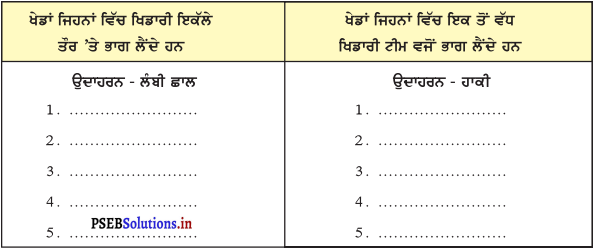
![]()
![]()
![]()

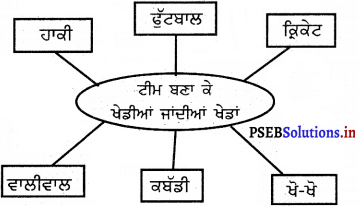

![]()
![]()
![]()
![]()
![]()
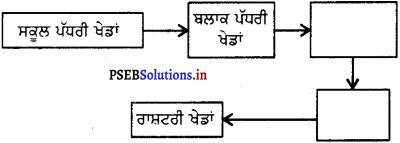

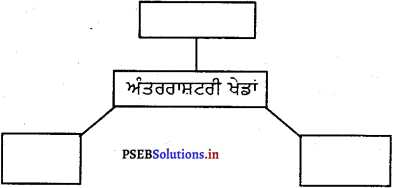
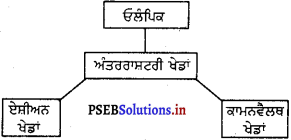
![]()


